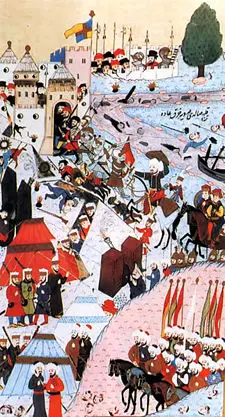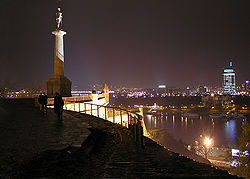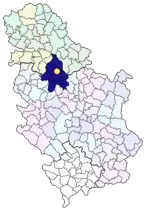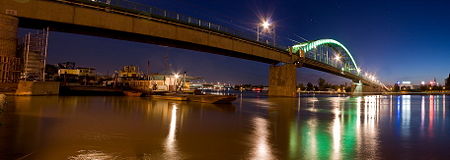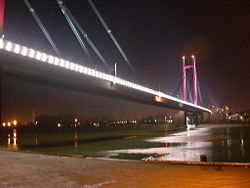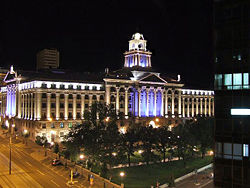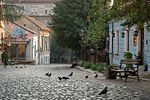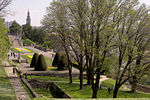|
|
| (99 intermediate revisions by 6 users not shown) |
| Line 1: |
Line 1: |
| | + | {{Images OK}}{{Submitted}}{{Approved}}{{Copyedited}} |
| | <!-- Infobox begins —> | | <!-- Infobox begins —> |
| | {{Infobox Settlement | | {{Infobox Settlement |
| − | |- bgcolor="#BBDDFF" | + | |official_name = Belgrade |
| − | |name = Belgrade
| + | |native_name = Београд |
| − | |official_name = City of Belgrade | |
| | |other_name = Beograd | | |other_name = Beograd |
| − | |native_name = Београд | + | |settlement_type = City |
| − | |nickname =
| + | |image_skyline = NoviBG Nov30 2005.jpg |
| − | |motto =
| + | |nickname = |
| − | |image_skyline = Belgrade iz balona.jpg | + | |imagesize = 250px |
| − | |imagesize = 240px | + | |image_caption = [[Pobednik]] monument in [[Belgrade fortress|Kalemegdan]], overlooking the skyline of [[Novi Beograd]] |
| − | |image_caption = Aerial view of Belgrade downtown and river shores | |
| | |image_flag = Flag of Belgrade.svg | | |image_flag = Flag of Belgrade.svg |
| | |flag_size = | | |flag_size = |
| − | |image_seal = | + | |image_seal = |
| | |image_shield = Coat of Arms Belgrade.png | | |image_shield = Coat of Arms Belgrade.png |
| − | |shield_size = | + | |shield_size = |
| | |image_map = Serbia_Belgrade.png | | |image_map = Serbia_Belgrade.png |
| − | |mapsize = 120px | + | |mapsize = 150px |
| | |map_caption = Location of Belgrade within Serbia | | |map_caption = Location of Belgrade within Serbia |
| − | |subdivision_type = [[Countries of the world|Country]] | + | |coordinates_region = RS |
| | + | |subdivision_type = Country |
| | |subdivision_name = {{flag|Serbia}} | | |subdivision_name = {{flag|Serbia}} |
| | |subdivision_type1 = [[Districts of Serbia|District]] | | |subdivision_type1 = [[Districts of Serbia|District]] |
| Line 25: |
Line 25: |
| | |subdivision_type2 = [[Municipalities of Serbia|Municipalities]] | | |subdivision_type2 = [[Municipalities of Serbia|Municipalities]] |
| | |subdivision_name2 = [[#Municipalities|17]] | | |subdivision_name2 = [[#Municipalities|17]] |
| − | |government_type = | + | |government_type = |
| | |leader_title = [[Mayor of Belgrade|Mayor]] | | |leader_title = [[Mayor of Belgrade|Mayor]] |
| − | |leader_name = [[Branislav Belić]] ([[Democratic Party (Serbia)|DS]]) (acting) | + | |leader_name = [[Dragan Đilas]] ([[Democratic Party (Serbia)|DS]]) |
| − | |leader_title1 = [[List of political parties in Serbia|Ruling parties]] (interim) | + | |leader_title1 = [[List of political parties in Serbia|Ruling parties]] |
| − | |leader_name1 = [[Democratic Party (Serbia)|DS]]/[[G17+]]/[[Socialist Party of Serbia|SPS]]/[[Liberal Democratic Party (Serbia 2005)|LDP]] | + | |leader_name1 = [[Democratic Party (Serbia)|DS]]/[[G17+]]/[[Socialist Party of Serbia|SPS]]-[[Party of United Pensioners of Serbia|PUPS]]/[[Liberal Democratic Party (Serbia 2005)|LDP]] |
| − | |leader_title2 =
| + | |established_title = Establishment |
| − | |leader_name2 =
| + | |established_date = before 279 B.C.E. ([[Singidunum]])<ref>{{cite web|url=http://www.beograd.rs/cms/view.php?id=201172|title=Ancient Period|publisher=City of Belgrade|date=|accessdate=March 16, 2012}}</ref> |
| − | |leader_title3 =
| + | |area_footnotes = <ref>{{cite web|url=http://www.beograd.rs/cms/view.php?id=201197|title=Territory|publisher=City of Belgrade|accessdate=March 16, 2012}}</ref> |
| − | |leader_name3 =
| + | |area_magnitude = |
| − | |established_title = Founded | + | |area_total_km2 = |
| − | |established_date = '''269 [[Before Christ|B.C.]]''' | + | |area_total_sq_mi = |
| − | |established_title2 = City rights | + | |area_land_km2 = |
| − | |established_date2 = '''150 [[Anno Domini|A.D.]]''' | + | |area_land_sq_mi = |
| − | |established_title3 = | |
| − | |established_date3 = | |
| − | |area_footnotes = | |
| − | |area_magnitude = | |
| − | |area_total_km2 = 3222.68 | |
| − | |area_total_sq_mi = | |
| − | |area_land_km2 = | |
| − | |area_land_sq_mi = | |
| | |area_water_km2 = | | |area_water_km2 = |
| − | |area_water_sq_mi = | + | |area_water_sq_mi = |
| − | |area_water_percent = | + | |area_water_percent = |
| − | |area_urban_km2 = 1035.0 | + | |area_total_km2 = 359.96 |
| − | |area_urban_sq_mi = | + | |area_urban_km2 = 869 |
| − | |area_metro_km2 = | + | |area_metro_km2 = 3222.68 |
| − | |area_metro_sq_mi = | + | |area_metro_sq_mi = |
| − | |area_blank1_title = | + | |area_blank1_title = |
| − | |area_blank1_sq_mi = | + | |area_blank1_sq_mi = |
| − | |area_blank1_km2 = | + | |area_blank1_km2 = |
| − | |area_blank2_title = | + | |area_blank2_title = |
| − | |area_blank2_sq_mi = | + | |area_blank2_sq_mi = |
| − | |area_blank2_km2 = | + | |area_blank2_km2 = |
| − | |population_as_of = 2008. | + | |population_as_of = 2011 |
| − | |population_footnotes = | + | |population_footnotes = <ref>{{citation|url=http://webrzs.stat.gov.rs/WebSite/repository/documents/00/00/49/86/Prvi_rezultati_Konferencija.pps |title=PRVI REZULTATI, Konferencija za novinare |publisher=Statistical Office of the Republic of Serbia |language=Serbian |date=2011-11-15 |page=11}} Retrieved March 16, 2012.</ref> |
| − | <ref name=popis>{{cite book | + | |population_note = |
| − | |author=Statistical Office of the Republic of Serbia
| + | |population_total = {{increase}} 1154589 |
| − | |title=Национална или етничка припадност - подаци по насељима
| + | |population_density_km2 = 3207.5 |
| − | |url=http://webrzs.statserb.sr.gov.yu/axd/Zip/NEP1.pdf
| + | |population_density_sq_mi = |
| − | |format=PDF
| + | |population_metro = {{increase}}1,639,121 |
| − | |accessdate=2006-10-29
| + | |population_density_metro_km2 = 508.6 |
| − | |edition = Књиге резултата Пописа 2002.
| + | |population_density_metro_sq_mi = |
| − | |year=2008 estimate
| + | |population_demonym = Belgrader |
| − | |publisher=Statistical Office of the Republic of Serbia | |
| − | |location=Belgrade
| |
| − | |language=Serbian
| |
| − | |page=14
| |
| − | }}</ref> | |
| − | |population_note = | |
| − | |population_total = 2 005 000 | |
| − | |population_density_km2 = 7450 | |
| − | |population_density_sq_mi = | |
| − | |population_metro_km2 = | |
| − | |population_density_metro_km2 = | |
| − | |population_density_metro_sq_mi = | |
| − | |population_urban = 2 500 000 | |
| − | |population_density_urban_sq_mi =
| |
| − | |population_density_urban_km2 = 4880
| |
| − | |population_blank1_title =
| |
| − | |population_blank1 =
| |
| | |population_density_blank1_km2 = | | |population_density_blank1_km2 = |
| | |population_density_blank1_sq_mi = | | |population_density_blank1_sq_mi = |
| Line 92: |
Line 67: |
| | |population_density_blank2_km2 = | | |population_density_blank2_km2 = |
| | |population_density_blank2_sq_mi = | | |population_density_blank2_sq_mi = |
| − | |timezone = [[Central European Time|CET]] | + | |timezone = [[Central European Time|CET]] |
| − | |utc_offset = +1 | + | |utc_offset = +1 |
| − | |timezone_DST = [[Central European Summer Time|CEST]] | + | |timezone_DST = [[Central European Summer Time|CEST]] |
| − | |utc_offset_DST = +2 | + | |utc_offset_DST = +2 |
| − | |latd = 44|latm= 49|lats =14|latNS = N | + | |latd = 44|latm= 49|lats =14|latNS = N |
| − | |longd = 20|longm = 27|longs =44|longEW = E | + | |longd = 20|longm = 27|longs =44|longEW = E|coordinates_display=3 |
| − | |elevation_footnotes = | + | |elevation_footnotes = |
| − | <ref>{{cite web|url=http://www.beograd.rs/cms/view.php?id=201029|title=Geographical Position|publisher=Official website of City of Belgrade|accessdate=2007-07-10}}</ref> | + | <ref>{{cite web|url=http://www.beograd.rs/cms/view.php?id=201029|title=Geographical position|publisher=City of Belgrade|accessdate=March 16, 2012}}</ref> |
| − | |elevation_m = 117 | + | |elevation_m = 117 |
| − | |elevation_ft = | + | |elevation_ft = 384 |
| − | |postal_code_type = Postal code | + | |postal_code_type = Postal code |
| − | |postal_code = 11000 | + | |postal_code = 11000 |
| − | |area_code = (+381) 11 | + | |area_code = (+381) 11 |
| − | |website = [http://www.beograd.rs/ www.beograd.rs] | + | |website = [http://www.beograd.rs/ www.beograd.rs] |
| − | |blank_name = [[Serbian vehicle registration plates|Car plates]] | + | |blank_name = [[Vehicle registration plates of Serbia|Car plates]] |
| − | |blank_info = BG | + | |blank_info = BG |
| | }} <!-- Infobox ends —> | | }} <!-- Infobox ends —> |
| − | '''Belgrade''' ({{lang-sr|Београд, ''Beograd''}} {{Audio|sr-beograd.ogg|listen}}), is the [[capital]] and largest city of [[Serbia]]. With a population of over 1.9 million (estimate 2008), Belgrade is the largest city in the territory of the [[former Yugoslavia]] and the fourth largest in [[South Eastern Europe#Southeastern Europe|Southeastern Europe]], after [[Istanbul]], [[Athens]], and [[Bucharest]].
| |
| | | | |
| − | One of [[Europe]]'s oldest cities, with a history of 7000 years, Belgrade's wider city area was the birthplace of the largest prehistoric culture of [[Europe]], the [[Vinča culture]]. The foundation of the city itself dates back to [[Celts|Celtic]] and later, [[Roman Empire|Roman]] periods, followed by the settlement of [[Slavs]] around the 7th century. In medieval times, it was in the possession of [[Byzantine Empire|Byzantine]], [[Frankish]], [[First Bulgarian Empire|Bulgarian]], [[Kingdom of Hungary in the Middle Ages|Hungarian]] and [[Serbian Despotate|Serbian]] rulers, until it was conquered by the [[Ottoman Empire|Ottomans]] in 1521 and became the seat of the [[Pashaluk of Belgrade]]. It became the capital of an [[Kingdom of Syrmia|independent Serbian state]] for the first time in 1284 (lost to [[Kingdom of Hungary|Hungary]] in 1427), the status that it would regain only in 1841, after the [[Serbian revolution|liberation from the Ottomans]]. In the 20th century, it was also the capital of several incarnations of [[Yugoslavia]], up to 2006, when Serbia became an independent state again.
| + | '''Belgrade''' is the [[capital]] and largest city of [[Serbia]]. The city lies at the confluence of the [[Sava River|Sava]] and [[Danube]] Rivers in north central Serbia, where the [[Pannonian Plain]] meets the [[Balkan Peninsula]]. With a population of over 1.9 million (estimate 2008), Belgrade is the largest city in the territory of the former [[Yugoslavia]] and the fourth largest in [[Southeastern Europe]], after [[Istanbul]], [[Athens]], and [[Bucharest]]. |
| | | | |
| − | Belgrade has the status of a separate territorial unit in Serbia, with its own autonomous city government. It covers 3.6% of the territory of Serbia, and 21% of the Serbian population lives in the city. Belgrade is the central economic hub of Serbia, and the capital of [[Serbian culture]], [[Education in Serbia|education]] and science.
| + | One of [[Europe]]'s oldest cities, with a history of 7000 years, Belgrade's wider city area was the birthplace of the largest [[prehistory|prehistoric]] culture of Europe, the [[Vinča culture]]. The foundation of the city itself dates back to [[Celts|Celtic]] and later, [[Roman Empire|Roman]] periods, followed by the settlement of [[Slavs]] around the seventh century. Since ancient times it has been an important focal point for commercial traffic, an intersection of the roads of Eastern and Western Europe. Today it is the central economic hub of Serbia, and the capital of culture, education and science. |
| | + | {{toc}} |
| | + | The city suffered from corruption and abuse of power during the [[Slobodan Milošević|Miloševic]]-era, including mismanagement of the economy, as well as from years of economic sanctions, [[war]]s and damage to the [[infrastructure]]. A focus of the city's, and the nation's, leaders has been stabilization of the economic and social services systems. The government has committed itself to pursue socially accountable policy in an attempt to avoid social stratification of the population which has occurred in some former [[socialism|socialist]] countries during their periods of transition. |
| | | | |
| | ==Geography== | | ==Geography== |
| | [[Image:Beograd Sat.jpg|250px|thumb|left|Satellite view of Belgrade.]] | | [[Image:Beograd Sat.jpg|250px|thumb|left|Satellite view of Belgrade.]] |
| − | Etymology of name – if available.
| + | Belgrade lies at the confluence of the [[Sava River|Sava]] and [[Danube]] rivers in north central [[Serbia]], where the [[Pannonian Plain]] meets the [[Balkan Peninsula]]. There, three trade routes exist - one from [[Vienna]] to the [[Black Sea]] along the Danube River valley, another along the Sava River valley toward [[Trieste]], and a third along the Morava and Vardar rivers to the [[Aegean Sea]]. |
| | | | |
| − | Belgrade lies at the confluence of the [[Sava River|Sava]] and [[Danube]] Rivers in north central Serbia, where the [[Pannonian Plain]] meets the [[Balkan Peninsula]]. The city is located at the convergence of three trade routes - one from [[Vienna]] to the [[Black Sea]]
| + | On the right bank of the Sava, central Belgrade has hilly terrain, while the highest point of Belgrade proper is [[Torlak (Belgrade)|Torlak hill]] at 994 feet (303 meters). The [[mountain]]s of [[Avala]], at 1677 feet (511 meters), and [[Kosmaj]], 2060 feet (628 meters) lie south of the city. Across the Sava and Danube, the land is mostly flat, consisting of [[alluvial plain]]s and [[loam|loessial]] [[plateau]]s. |
| − | along the Danube River valley, another along the Sava River valley toward [[Trieste]], and a third along the Morava and Vardar rivers to the [[Aegean Sea]]. Belgrade is at an elevation of 383 feet (116.75 meters) above [[sea level]].
| |
| | | | |
| − | On the right bank of the Sava, central Belgrade has hilly terrain, while the highest point of Belgrade proper is [[Torlak (Belgrade)|Torlak hill]] at 994 feet (303 meters). The mountains of [[Avala]], at 1677 feet (511 meters), and [[Kosmaj]], 2060 feet (628 meters) lie south of the city. Across the Sava and Danube, the land is mostly flat, consisting of [[alluvial plain]]s and [[loam|loessial]] [[plateau]]s.
| + | The Danube flows through over 37 miles (60 km) of the area, while the Sava covers nearly 19 miles (30 km). The city's riverbanks cover 124 miles (200 km). There are 16 river islands in the area, the best known being Ada Ciganlija, Veliko ratno ostrvo and Gročanska ada. Belgrade also has many wooded areas, such as Kosmaj, Avala, Trešnja, Lipovica, Topčider, Obrenovački zabran and Bojčin. |
| | + | |
| | + | Belgrade has a moderate [[continental climate]]. The hottest month is July, with an average [[temperature]] of 71.8°F (22.1°C), and the January temperature averages 34°F (1°C). Belgrade receives 27.56 inches (700mm) of precipitation a year. |
| | | | |
| − | Belgrade has a moderate [[continental climate]]. The hottest month is July, with an average temperature of 71.8°F (22.1°C), and the January temperature averages 34°F (1°C). Belgrade receives 27.56 inches (700mm) of precipitation a year. | + | The historical core of Belgrade (today's Kalemegdan) is on the right bank of the rivers. Since the nineteenth century, the city has expanded south and east, and after [[World War II]], New Belgrade was built on the Sava's left bank, merging Belgrade with [[Zemun]]. Smaller residential communities across the Danube, such as [[Krnjača]] and [[Ovča]], also merged with the city. |
| | | | |
| − | The historical core of Belgrade (today's [[Kalemegdan]]) is on the right bank of the rivers. Since the 19th century, the city has been expanding to the south and east, and after [[World War II]], [[Novi Beograd|New Belgrade]] was built on the Sava's left bank, merging Belgrade with [[Zemun]]. Smaller, chiefly residential communities across the Danube, like [[Krnjača]] and [[Ovča]], also merged with the city.
| + | The city has an urban area of 139 square miles (360 square kilometers), while its metropolitan area covers 1244.4 square miles (3223 square kilometers). |
| − | | |
| − | The city has an urban area of 139 square miles (360 square kilometers), while together with its metropolitan area it covers 1244.4 square miles (3223 square kilometers). Throughout history, Belgrade has been a major crossroad between the [[Western world|West]] and [[the Orient]]. | |
| − | | |
| − | Environmental issues
| |
| | | | |
| | ==History== | | ==History== |
| − | {{seealso|Timeline of Belgrade history}}
| + | [[Image:Jovian1.jpg|thumb|right|225px|[[Jovian|Flavius Iovanus]], [[Roman Emperor]] from [[Singidunum]]]] |
| − | ===Ancient city===
| + | [[Image:Siege of Nandorfehervar.jpg|thumb|225px|right|The [[Siege of Belgrade]] in 1456.]] |
| − | [[Image:Jovian1.jpg|thumb|right|250px|[[Jovian|Flavius Iovanus]], [[Roman Emperor]] from [[Singidunum]]]] | + | [[Image:Kul jak.jpg|225px|thumb|right|Belgrade Fortress - Jakšić's Tower.]] |
| − | [[Image:Siege of Nándorfehérvár.jpg|thumb|250px|right|The [[Siege of Belgrade]] in 1456.]] | + | [[Image:Fortress Belgrade.jpg|225px|thumb|right|Belgrade in the sixteenth century]] |
| − | [[Image:Kul jak.jpg|250px|thumb|right|Belgrade Fortress - Jakšić's Tower.]] | + | [[Image:Belagerung belgrad 1717.jpg|thumb|right|225px|Austrian conquest of Belgrade: 1717 by [[Eugene of Savoy]], during the [[Austro-Turkish War of 1716-1718]]]] |
| − | [[Image:Fortress Belgrade.jpg|250px|thumb|right|Belgrade in the 16th century]] | + | [[Image:Knez stara.jpg|thumb|right|225px|Knez Mihailova street at the beginning of the twentieth century]] |
| − | [[Image:Belagerung belgrad 1717.jpg|thumb|right|250px|Austrian conquest of Belgrade: 1717 by [[Eugene of Savoy]], during the [[Austro-Turkish War of 1716-18]]]] | + | [[Image:Beograd - National Theater 02.jpg|thumb|right|225px|[[National Theatre in Belgrade]]]] |
| − | [[Image:Knez stara.jpg|thumb|right|250px|Knez Mihailova street at the beginning of the 20th century]] | + | [[Image:Belgrade Old Court 1.jpg|thumb|225px|The Old Palace, seat of the Assembly of the City of Belgrade.]] |
| − | [[Image:Knez Mihailo, Republic Square.jpg|thumb|right|250px|The statue of [[Mihailo Obrenović III, Prince of Serbia|Prince Mihailo]] on [[Republic Square (Belgrade)|Republic Square]].]] | + | The [[Neolithic]] [[Starčevo-Körös|Starčevo]] and [[Vinča culture]]s existed in or near Belgrade about 7000 years ago. Settled in the fourth century B.C.E. by a [[Celt]]ic tribe, the [[Scordisci]], the city's first recorded name was Singidūn, before becoming the [[Roman Empire|Roman]] settlement of [[Singidunum]] in the first century C.E. Roman Emperor [[Jovian]] (331-364), who re-established [[Christianity]] as the official religion of the Roman Empire, was born in Singidunum. In 395, the site passed to the Eastern Roman or [[Byzantine Empire]]. Across the Sava from Singidunum was the Celtic city of [[Zemun|Taurunum (Zemun)]]. |
| − | The [[Neolithic]] [[Starčevo-Körös|Starčevo]] and [[Vinča culture]]s existed in or near Belgrade and dominated the [[Balkans]] (as well as parts of [[Central Europe]] and [[Asia Minor]]) about 7,000 years ago. Settled in the fourth century BC by a [[Celt]]ic tribe, the [[Scordisci]], the city's first recorded name was Singidūn, before becoming the [[Roman Empire|Roman]] settlement of [[Singidunum]] in the first century AD. | |
| − | In the mid second century, the city was proclaimed a [[municipium]] by the Roman authorities, evolving into a full fledged [[Colonia (Roman)|colonia]] (highest class Roman city) by the end of the century. The first [[Christian]] [[Roman Emperor|Emperor of Rome]] was born in modern [[Serbia]]: [[Constantine I]] known as [[Constantine the Great]] ([[Niš|Naissus]], 280 C.E. and a Roman Emperor was born in Belgrade, [[Jovian]], the restorer of [[Christianity]], [[Flavius Iovianus]], ([[Singidunum]], 332 C.E. Jovian reestablished Christianity as the official religion of the [[Roman Empire]], ending the brief revival of paganism under his predecessor [[Julian]]. In 395 AD, the site passed to the Eastern Roman or [[Byzantine Empire]]. Across the Sava from Singidunum was the Celtic city of [[Zemun|Taurunum (Zemun)]], that through Roman and Byzantine times shared a common fate with its "twin brother" (the two cities were connected by a bridge).
| |
| | | | |
| − | ===Middle Ages=== | + | ===Slavs arrive=== |
| − | Singidunum was occupied and often ravaged by successive invasions of [[Huns]], [[Sarmatians]], [[Ostrogoths]] and [[Eurasian Avars|Avars]] before the arrival of the [[Slavic peoples|Slav]]s around 630 AD. The [[Avars]] were finally destroyed in the 9th century by the [[Frankish Kingdom]], which incorporated the former [[Taurunum]] into its territory (renaming it to Malevilla). At the same time (around 878), the first record of the [[Slavic languages|Slavic]] name ''Beligrad'' has appeared, during the rule of the [[First Bulgarian Empire]]. For about four centuries, the city remained a battleground between the [[Byzantine Empire]], the [[Kingdom of Hungary]] and the [[First Bulgarian Empire]]. The city hosted the armies of the [[First Crusade|First]] and the [[Second Crusade]]; while passing through during the [[Third Crusade]], [[Frederick Barbarossa]] and his 190,000 [[Third Crusade|crusaders]] saw Belgrade in ruins.<ref>[http://www.belgradenet.com/belgrade_history.html The History of Belgrade<!--Bot-generated title—>]</ref> Capital of the [[Kingdom of Syrmia]] since 1284, the first [[List of Serbian monarchs|Serbian king]] to rule over Belgrade was [[Stefan Dragutin|Dragutin]], who received it as a gift from his [[father-in-law]], the Hungarian king [[Stephen V of Hungary|Stephen V]].<ref name="MSH">{{citeweb|url=http://www.beograd.rs/cms/view.php?id=201247|title=History (Medieval Serbian Belgrade)|publisher=Official website|accessdate=2007-07-10}}</ref> | + | Singidunum was invaded by [[Huns]], [[Sarmatians]], [[Ostrogoths]] and [[Eurasian Avars|Avars]] before the arrival of the [[Slavic peoples|Slav]]s around 630. The [[Frankish Kingdom]] destroyed the [[Avars]] in the ninth century. The [[Slavic languages|Slavic]] name ''Beligrad'' appeared around 878, during the rule of the [[First Bulgarian Empire]]. The city remained a battleground between the [[Byzantine Empire]], the [[Kingdom of Hungary]], and the First Bulgarian Empire for about 400 years. The city hosted the armies of the [[First Crusade|First]] (launched 1096) and the [[Second Crusade]]s (1147–1149). While passing through during the [[Third Crusade]] (1189–1192), [[Frederick Barbarossa]] saw Belgrade in ruins. Capital of the [[Kingdom of Syrmia]] since 1284, the first Serbian king to rule over Belgrade was [[Stefan Dragutin|Dragutin]] (died 1316), who received it as a gift from his father-in-law, the Hungarian king [[Stephen V of Hungary|Stephen V]]. |
| − | Following the [[Battle of Maritsa]] in 1371, and the [[Battle of Kosovo]] in 1389, the [[Serbian Empire]] began to crumble as the [[Ottoman Empire]] conquered its southern territory.<ref>{{cite web|url=http://www.britannica.com/eb/article-9050991/Battle-of-the-Maritsa-River|title=Battle of Maritsa|publisher=Encyclopaedia Britannica|accessdate=2007-07-10}}</ref><ref>{{cite web|url=http://www.britannica.com/eb/article-9046112/Battle-of-Kosovo|title=Battle of Kosovo|publisher=Encyclopaedia Britannica|accessdate=2007-07-10}}</ref> The north, however, resisted through the [[Serbian Despotate]], which had Belgrade as its capital. The city flourished under [[Despotism|despot]] [[Stefan Lazarević]], son of the famous Serbian ruler [[Prince Lazar|Lazar Hrebeljanović]]. Lazarević built a castle with a citadel and towers, of which only the [[Despot Stefan Tower|Despot's tower]] and the west wall remain. He also refortified the city's ancient walls, allowing the Despotate to resist the Ottomans for almost 70 years. During this time, Belgrade was a haven for the many Balkan peoples fleeing from Ottoman rule, and is thought to have had a population of some 40–50,000.<ref name="MSH"/>
| |
| | | | |
| − | In 1427, Stefan's successor [[Đurađ Branković]] had to return Belgrade to the [[Kingdom of Hungary|Hungarians]], and the capital was moved to [[Smederevo fortress|Smederevo]]. During his reign, the Ottomans captured most of the [[Serbian Despotate]], unsuccessfully besieging Belgrade first in 1440<ref name = "beligrad_history">www.beligrad.com/history.htm</ref> and again in 1456.<ref name="corovic">{{cite book |last=Ćorović |first= Vladimir |authorlink=Vladimir Ćorović |title=Istorija srpskog naroda |url=http://www.rastko.org.yu/rastko-bl/istorija/corovic/istorija/index_l.html |year=1997 |publisher=[[Project Rastko]] |location=Banja Luka / Belgrade |language=Serbian |chapter=V. Despot Đurađ Branković | chapterurl = http://www.rastko.org.yu/rastko-bl/istorija/corovic/istorija/4_5_l.html |accessdate=2007-07-17|isbn=86-7119-101-X}}</ref> As it presented an obstacle to their further advance into [[Central Europe]], over 100,000 Ottoman solders<ref name = "belgradenet-middleages">[http://www.belgradenet.com/belgrade_history_middle_ages.html The History of Belgrade<!--Bot-generated title—>]</ref> have launched the famous [[Siege of Belgrade]], where the [[Christendom|Christian]] army under [[John Hunyadi]] successfully defended the city from the Ottomans, wounding the Sultan [[Mehmed II]]<ref>{{cite web|url=http://www.historynet.com/magazines/military_history/3030796.html|author=Tom R. Kovach|title=Ottoman-Hungarian Wars: Siege of Belgrade in 1456|publisher=Military History magazine|accessdate=2007-07-10}}</ref> This battle "decided the fate of Christendom";<ref>[http://wiki.viitorulroman.com/pmwiki.php/Heritage/JohnHunyadi Romanian Heritage | Heritage / JohnHunyadi<!--Bot-generated title—>]</ref> the ''[[noon bell]]'' ordered by [[Pope Callixtus III]] commemorates the victory throughout the Christian world to this day.<ref>[http://www.mek.oszk.hu/02000/02085/02085.htm Hungary: A Brief History]</ref><ref name = "beligrad_history"/>
| + | ===Belgrade a haven=== |
| | + | The [[Serbian Empire]] began to crumble after the [[Battle of Maritsa]] (1371), and the [[Battle of Kosovo]] (1389), as the [[Ottoman Empire]] conquered its southern territory. Belgrade flourished under [[Despotism|despot]] [[Stefan Lazarević]] (1374-1427), who refortified the city's ancient walls, allowing the Despotate to resist the Ottomans for almost 70 years. The city became a haven for the many Balkan peoples fleeing from Ottoman rule, and is thought to have had a population of some 40,000–50,000. |
| | | | |
| − | ===Turkish conquest / Austrian invasions===
| + | In 1427, Stefan's successor [[Đurađ Branković]] had to return Belgrade to the [[Kingdom of Hungary|Hungarians]], and the Serbian capital was moved to [[Smederevo fortress|Smederevo]]. During his reign, the Ottomans captured most of the [[Serbian Despotate]], unsuccessfully besieging Belgrade first in 1440 and again in 1456. Over 100,000 Ottoman soldiers launched the famous [[Siege of Belgrade]] (July 4 to July 22, 1456), where the [[Christian]] army under [[John Hunyadi]] successfully defended the city, wounding the Sultan [[Mehmed II]]. This battle was regarded as "deciding the fate of Christendom." |
| | | | |
| − | It wasn't until [[28 August]] [[1521]] (7 decades after the last siege), that the fort was finally captured by Sultan [[Suleyman the Magnificent]] and his 250,000 soldiers; subsequently, most of the city was razed to the ground and its entire Christian population deported to [[Istanbul]].<ref name = "beligrad_history"/> Belgrade was made the seat of the district ([[Sanjak]]), attracting new inhabitants—[[Turkic peoples|Turks]], [[Armenians]], [[Greeks]], [[Republic of Ragusa|Ragusan]] traders, and others, and there was peace for the next 150 years. The city became the second largest [[Ottoman Turks|Ottoman]] town in [[Europe]] at over 100,000 people, surpassed only by [[Constantinople]].<ref name = "belgradenet-middleages"/> Turkish rule also introduced [[Ottoman architecture]] to Belgrade and many [[mosque]]s were built, increasing the city's [[Oriental]] influences.<ref name="imperialrule">{{cite web|url=http://www.beograd.rs/cms/view.php?id=201251|title=History (Turkish and Austrian Rule)|publisher=Official website|accessdate=2007-07-10}}</ref> In 1594, a major [[Banat Uprising|Serb rebellion]] was crushed by the Turks. Further on, [[Albanian]]- born [[Grand vizier]] [[Sinan Pasha]]<ref>[http://www.frosina.org/culturehistory/reviews.asp?id=121 Welcome to Frosina.org :: An Albanian Immigrant and Cultural Resource<!--Bot-generated title—>]</ref> ordered the [[relic]]s of [[Saint Sava]] to be publicly torched on the [[Vračar plateau]]; more recently, the [[Temple of Saint Sava]] was built to commemorate this event.<ref>{{cite web|url=http://www.mitropolija.cg.yu/dvavoda/knjige/aradovic-hram_l.html|title=Duhovni smisao hrama Svetog Save na Vračaru (Online book reprint)|author=[[Amfilohije Radović]]|publisher=Janus, Belgrade|date=1989|language=Serbian|accessdate=2007-07-05}}</ref> In retaliation for the rebellion, most of the city's population was deported to [[Istanbul]]; the ''Belgrade Forest'' is, centuries on, still named after those Serbian refugees.<ref>[http://icdea.bahcesehir.edu.tr/istanbul.htm University of Bahçeşehir<!--Bot-generated title—>]</ref>
| + | ===Turkish conquest=== |
| | + | Sultan [[Suleyman the Magnificent]] (1494-1566) and his 250,000 soldiers captured the fort on August 28, 1521, razed most of the city, and deported its Christian population to [[Istanbul]]. Belgrade was made an Ottoman [[Sanjak]], attracting new inhabitants—[[Turkic peoples|Turks]], [[Armenia]]ns, [[Greece|Greeks]], [[Republic of Ragusa|Ragusan]] traders, and others – becoming the second largest [[Ottoman Turks|Ottoman]] town in [[Europe]] with over 100,000 people. Turkish rule introduced Ottoman [[architecture]] and built many [[mosque]]s. |
| | | | |
| − | Occupied by [[Habsburg Monarchy|Austria]] three times (1688–1690, 1717–1739, 1789–1791), headed by the [[Holy Roman Empire|Holy Roman Princes]] [[Maximilian of Bavaria]] and [[Eugene of Savoy]],<ref>http://razgledanje.tripod.com/tvrdjava/english.htm</ref> respectively, Belgrade was quickly recaptured and substantially razed each time by the Ottomans.<ref name="imperialrule"/> During this period, the city was affected by the two [[Great Serbian Migrations]], in which hundreds of thousands of Serbs, led by their [[Patriarch of Serbia|patriarchs]], retreated together with the Austrians into the Habsburg Empire, settling in today's [[Vojvodina]] and [[Slavonia]].<ref>{{cite book|url=http://www.suc.org/culture/library/Oci/tajne-poruke-svetoga-save-16-03-03.html|title=Oči u oči|chapter=Tajne poruke svetog Save" Svetosavka crkva i velika seoba Srba 1690. godine|authorlink=Dejan Medaković|publisher=[[BIGZ]] (online reprint by Serbian Unity Congress library)|location=Belgrade| |isbn=978-8613009030|last=Medaković|first=Dejan|accessdate=2007-05-17|year=1990}}</ref>
| + | In 1594, the Turks crushed a Serb rebellion. [[Albania]]n- born [[Grand vizier]] [[Sinan Pasha]] (1506-1596) is disdained by the Serbs for ordering, in 1595, that the relics of [[Saint Sava]], the founder of the independent [[Serbian Orthodox Church]] in the twelfth century, be burned as a revenge for Serbs siding with the [[Habsburg]]s in the preceding border skirmishes. Further deportations to [[Istanbul]] followed. |
| | | | |
| − | ===Serbian capital=== | + | ===Austrian occupation=== |
| | + | Habsburg Austria occupied Belgrade three times (1688–1690, 1717–1739, 1789–1791), but the [[Ottoman Empire|Ottomans]] recaptured and razed the city each time. This was the period of the two [[Great Serbian Migrations]], in which hundreds of thousands of Serbs, led by their patriarchs, retreated together with the Austrians into the Habsburg Empire, settling in today's [[Vojvodina]] and [[Slavonia]]. |
| | | | |
| − | During the [[First Serbian Uprising]], the Serbian revolutionaries held the city from [[8 January]] [[1806]] until 1813, when it was retaken by the Ottomans.<ref name="bglib">{{cite web|url=http://www.beograd.rs/cms/view.php?id=201255|title=History (Liberation of Belgrade)|publisher=Official website|accessdate=2007-07-10}}</ref> After the [[Second Serbian Uprising]] in 1817, Serbia reached semi-independence, which was formally recognized by the [[Porte]] in 1830.<ref>{{cite paper|title=Nations into States: National Liberations in Former Yugoslavia|last=Pavkovic|first=Aleksandar|publisher=The Australian National University|date=2001-10-19|accessdate=2007-07-21}}</ref> In 1841, Prince [[Mihailo Obrenović]] moved the capital from [[Kragujevac]] to Belgrade.<ref>{{cite web|url=http://www.kragujevac.org.yu/en/history.htm|title=History of Kragujevac|publisher=Official website of Kragujevac|accessdate=2007-05-17}}</ref><ref name="history">{{cite web|url=http://www.beograd.rs/cms/view.php?id=201239 |title=History (Important Years Through City History)|publisher=Official website|accessdate=2007-07-10}}</ref> | + | ===Serbian uprisings=== |
| − | | + | During the [[First Serbian Uprising]], the Serbian revolutionaries held the city from January 8, 1806, until 1813, when the Ottomans retook the city. After the [[Second Serbian Uprising]] in 1817, Serbia reached semi-independence, which the Ottoman Porte recognized in 1830. When Serbia reached full independence in 1878, and became the [[Kingdom of Serbia]] in 1882, Belgrade became a key [[city]], but Serbia remained overwhelmingly agrarian and poor. In 1900, the capital had only 69,100 inhabitants, by 1905 the population had grown to more than 80,000, and by the outbreak of [[World War I]] in 1914, it had surpassed the 100,000 citizens. |
| − | With the [[Principality of Serbia|Principality]]'s full independence in 1878, and its transformation into the [[Kingdom of Serbia]] in 1882, Belgrade once again became a key city in the Balkans, and developed rapidly.<ref name="bglib">src</ref><ref name="20c">{{cite web|url=http://www.beograd.rs/cms/view.php?id=201259|title=History (The Capital of Serbia and Yugoslavia)|publisher=Official website|accessdate=2007-07-10}}</ref> Nevertheless, conditions in Serbia as a whole remained those of an overwhelmingly agrarian country, even with the opening of a railway to [[Niš]], Serbia's second city, and in 1900 the capital had only 69,100 inhabitants.<ref>{{cite web|url=http://www.populstat.info/Europe/yugoslft.htm|title=The Yugoslav Federation: Historical demographical data of the urban centers|publisher=www.populstat.info|date=2003-02-03|accessdate=2007-05-17|author=Jan Lahmeyer}}
| |
| − | </ref> Yet by 1905 the population had grown to more than 80,000, and by the outbreak of [[World War I]] in 1914, it had surpassed the 100,000 citizens, not counting [[Zemun]] which then belonged to [[Austria-Hungary]].<ref>{{ws|"[[s:Catholic Encyclopedia (1913)/Belgrade and Smederevo|Belgrade and Smederevo]]" in the 1913 ''Catholic Encyclopedia'' - Retrieved on 2007-10-16}}</ref>
| |
| − | | |
| − | The first-ever projection of motion pictures in the [[Balkans]] and [[Central Europe]] was held in Belgrade in June 1896 by Andre Carr, a representative of the [[Auguste and Louis Lumière|Lumière brothers]]. He shot the first motion pictures of Belgrade in the next year; however, they have not been preserved.<ref>{{cite book|url=http://www.rastko.org.yu/isk/index_e.html|chapterurl=http://www.rastko.org.yu/isk/dkosanovic-cinematography.html|title=The history of Serbian Culture|chapter=Serbian Film and Cinematography (1896-1993)|last=Kosanovic|first=Dejan|isbn=1-870732-31-6|publisher=Porthill Publishers|origyear=1995|accessdate=2007-07-10}}</ref><!-- [[Johann Strauss II]] performed in the city the same year.—>
| |
| | | | |
| | ===World War I=== | | ===World War I=== |
| − | [[Gavrilo Princip]]'s [[assassination of Archduke Franz Ferdinand]] of Austria and his wife Sophie, Duchess of Hohenberg, in [[Sarajevo]] on [[28 June]] [[1914]] triggered [[World War I]]. Most of the subsequent Balkan offensives occurred near Belgrade. [[Austro-Hungarian Navy|Austro-Hungarian]] [[Monitor (warship)|monitors]] shelled Belgrade on [[29 July]] [[1914]], and it was taken by the [[Austro-Hungarian Army]] under General [[Oskar Potiorek]] on [[30 November]]. On [[15 December]], it was re-taken by [[Serbian Campaign (World War I)|Serbian troops]] under Marshal [[Radomir Putnik]]. After a prolonged battle which destroyed much of the city, between [[6 October]] and [[9 October]] [[1915]], Belgrade fell to [[German Army|German]] and Austro-Hungarian troops commanded by Field Marshal [[August von Mackensen]] on [[9 October]] [[1915]]. The city was liberated by Serbian and [[French Army|French troops]] on [[5 November]] [[1918]], under the command of Marshal [[Louis Franchet d'Espérey]] of [[France]] and [[Alexander I of Yugoslavia|Crown Prince Alexander of Serbia]]. Decimated as the front-line city, for a while it was [[Subotica]]<ref>[http://www.balkanology.com/serbia/article_vojvodina.html Balkanology :: Serbia :: Vojvodina<!--Bot-generated title—>]</ref> that was the largest city in the [[Kingdom of Yugoslavia|Kingdom]]; still, Belgrade grew rapidly, retrieving its position by the early 1920s. | + | [[Gavrilo Princip]]'s [[assassination]] of Archduke [[Franz Ferdinand]] of Austria and his wife Sophie, Duchess of Hohenberg, in [[Sarajevo]] on June 28, 1914, triggered [[World War I]]. The [[Austro-Hungarian Army]] took Belgrade on November 30, 1914, but Serbian troops took the city on December 15. Belgrade fell to German and Austro-Hungarian troops on October 9, 1915. The city was liberated by Serbian and French troops on November 5, 1918. |
| − | | |
| − | After the war, Belgrade became the capital of the new Kingdom of Serbs, Croats and Slovenes, renamed the [[Kingdom of Yugoslavia]] in 1929. The Kingdom was split into [[Subdivisions of the Kingdom of Yugoslavia|banovinas]], and Belgrade, together with [[Zemun]] and [[Pančevo]], formed a separate administrative unit.<ref>ISBN 86-17-09287-4: Kosta Nikolić, Nikola Žutić, Momčilo Pavlović, Zorica Špadijer: Историја за трећи разред гимназије, Belgrade, 2002, pg. 144</ref>
| |
| | | | |
| − | During this period, the city experienced faster growth and significant modernisation. Belgrade's population grew to 239,000 by 1931 (incorporating the town of [[Zemun]], formerly in Austria-Hungary), and 320,000 by 1940. The population growth rate between 1921 and 1948 averaged 4.08% a year.<ref name="stan">{{cite journal
| + | After the war, Belgrade became the capital of the new Kingdom of Serbs, Croats and Slovenes, renamed the [[Yugoslavia|Kingdom of Yugoslavia]] in 1929. The kingdom was split into ''banovinas,'' and Belgrade, together with [[Zemun]] and [[Pančevo]], formed a separate administrative unit. Belgrade's population grew to 239,000 by 1931 (incorporating the town of Zemun, formerly in Austria-Hungary), and 320,000 by 1940. In 1927, Belgrade's first [[airport]] opened, and in 1929, its first [[radio]] station began broadcasting. The [[Pančevo Bridge]] across the [[Danube]] was opened in 1935. |
| − | |url=http://nainfo.nbs.bg.ac.yu/sfoa/pdfovi/0350-03730101087P.pdf |title=Industrija i urbani razvoj Beograda|last=Petrović|first=Dragan|journal=Industrija|year=2001|volume=21, No. 1–4|pages=87–94|accessdate=2007-07-10|issn=0350-0373|format=PDF}}</ref> In 1927, Belgrade's first airport opened, and in 1929, its first radio station began broadcasting. The [[Pančevo Bridge]], which crosses the Danube, was opened in 1935.<ref>{{cite web|url=http://www.serbia-info.com/g3/images/1930-50-e.htm|title=Twentieth Century - Innovations in Belgrade|publisher=Serbia-info.com (Government of Serbia website)|accessdate=2007-07-21}}</ref>
| |
| − | [[Image:Beograd - National Theater 02.jpg|thumb|left|[[National Theatre in Belgrade]]]]
| |
| | | | |
| | ===World War II=== | | ===World War II=== |
| − | On [[25 March]] [[1941]], the government of [[regent]] [[Prince Paul of Yugoslavia|Crown Prince Paul]] signed the [[Tripartite Pact]], joining the [[Axis powers of World War II|Axis powers]] in an effort to stay out of the [[Second World War]]. This was immediately followed by mass protests in Belgrade and a military [[coup d'état]] led by Air Force commander General [[Dušan Simović]], who proclaimed [[Peter II of Yugoslavia|King Peter II]] to be of age to rule the realm. Consequently, the city was [[Bombing of Belgrade in World War II#German bombing|heavily bombed]] by the [[Luftwaffe]] on [[6 April]] [[1941]], and up to 17,000 citizens were killed.<ref>[http://www.army.mil/CMH/books/wwii/balkan/20_260_2.htm THE GERMAN CAMPAIGN IN THE BALKANS (SPRING 1941): PART II<!--Bot-generated title—>]</ref> [[Yugoslavia]] was then [[Invasion of Yugoslavia|invaded]] by [[Nazi Germany|German]], [[Italian fascism|Italian]], [[Hungary between the two world wars|Hungarian]], and [[Military history of Bulgaria during World War II|Bulgarian]] forces, and suburbs as far east as [[Zemun]], in the Belgrade metropolitan area, were incorporated into a Nazi [[puppet state]], the [[Independent State of Croatia]]. Belgrade became the seat of [[Nedić's Serbia|another puppet government]], headed by General [[Milan Nedić]]. | + | On March 25, 1941, the government of regent Crown Prince Paul signed the [[Tripartite Pact]] with the [[Axis powers]] to avoid [[war]]. This sparked mass protests in Belgrade and a military [[coup d'état]] led by Air Force commander General [[Dušan Simović]], who proclaimed King Peter II to be of age to rule the realm. The German [[Luftwaffe]] bombed the city on April 6, 1941, and up to 17,000 citizens were killed. German, Italian, Hungarian, and Bulgarian forces invaded [[Yugoslavia]]. Belgrade's eastern suburbs were incorporated into a Nazi [[puppet state]], the [[Independent State of Croatia]], while Belgrade became the seat of another puppet government, headed by General [[Milan Nedić]]. |
| − | | |
| − | During the summer and fall of 1941, in reprisal for guerrilla attacks, Germans carried out several massacres of Belgrade citizens; in particular, members of the [[History of the Jews in Serbia|Jewish]] community were subject to mass shootings at the order of General [[Franz Böhme]], the German Military Governor of Serbia. Böhme rigorously enforced the rule that for every German killed, 100 Serbs or Jews would be shot.<ref>{{cite book|last=Rubenstein|first=Richard L|coauthors=Roth, John king|title=Approaches to Auschwitz: The Holocaust and Its Legacy|year=2003|publisher=Westminster John Knox Press|isbn=0664223532|pages=170|url=http://www.questia.com/library/book/approaches-to-auschwitz-the-holocaust-and-its-legacy-by-john-k-roth-richard-l-rubenstein.jsp}}</ref>
| |
| | | | |
| − | [[Bombing of Belgrade in World War II#Allied bombing|Belgrade was bombed]] by the [[Allies of World War II|Allies]] on [[16 April]] [[1944]], killing about 1,600 people. Both this and the earlier Luftwaffe bombing fell on the [[Eastern Orthodox Church|Orthodox Christian]] [[Easter#Eastern Christianity 2|Easter]]. Most of the city remained under German occupation until [[20 October]] [[1944]], when it was liberated by [[Communism|Communist]] [[Partisans (Yugoslavia)|Yugoslav Partisans]] and the [[Red Army]]. On [[29 November]] [[1945]], Marshal [[Josip Broz Tito]] proclaimed the [[Federal People's Republic of Yugoslavia]] in Belgrade (later to be renamed to [[Socialist Federal Republic of Yugoslavia]] on [[7 April]] [[1963]]).
| + | During the summer and fall of 1941, in reprisal for [[guerrilla war|guerrilla]] attacks, Germans carried out several massacres of Belgrade citizens; in particular, members of the [[Jewish]] community were subject to mass shootings. General [[Franz Böhme]], the German Military Governor of Serbia, rigorously enforced the rule that for every German killed, 100 Serbs or Jews would be shot. |
| | | | |
| − | During the post-war period, Belgrade grew rapidly as the capital of the renewed Yugoslavia, developing as a major industrial centre.<ref name="20c"/> In 1958, Belgrade's first television station began broadcasting. In 1961, the conference of [[Non-Aligned Movement|Non-Aligned Countries]] was held in Belgrade under Tito's chairmanship. In 1968, major student protests against Tito led to several street clashes between students and the police, ending with Tito's famous saying, "Students are right!". In March 1972, Belgrade was at the centre of [[1972 outbreak of smallpox in Yugoslavia|the last major outbreak of smallpox in Europe]], which, through enforced quarantine and mass vaccination, was contained by late May.<ref>{{cite web|url=http://www.npr.org/news/specials/response/anthrax/features/2001/oct/011023.quarantine.html|title=Bioterrorism: Civil Liberties Under Quarantine|publisher=[[NPR]]|date=2001-10-23|accessdate=2007-05-19}}</ref>
| + | The Allies bombed Belgrade on April 16, 1944, killing 1600 people. Communist Yugoslav Partisans and the [[Red Army]] liberated the city on October 20, 1944. On November 29, 1945, Marshal [[Josip Broz Tito]] proclaimed the [[Federal People's Republic of Yugoslavia]] in Belgrade (later to be renamed to [[Socialist Federal Republic of Yugoslavia]] on April 7, 1963). |
| − | | |
| − | ===Post-communist history===
| |
| − | [[Image:Belgrade Kalemegdan&Pobednik.JPG|250px|thumb|right|[[Pobednik]] (''The Victor''), a symbol of Belgrade]]
| |
| − | On [[9 March]] [[1991]], [[March 9, 1991 protest|massive demonstrations]] led by [[Vuk Drašković]] were held in the city against [[Slobodan Milošević]].<ref>{{cite web|url=http://www.danas.co.yu/20060309/hronika1.html|title=Prvi udarac Miloševićevom režimu|publisher=[[Danas]]|date=2006-03-09|language=Serbian|accessdate=2007-07-10}}</ref> According to various media outlets, there were between 100,000 and 150,000 people on the streets.<ref>{{cite web|url=http://www.time.com/time/magazine/article/0,9171,972607-1,00.html |title=Yugoslavia: Mass bedlam in Belgrade|publisher=[[Time (magazine)|TIME]]|author=James L. Graff|date=1991-03-25|accessdate=2007-07-10}}</ref> Two people were killed, 203 injured and 108 arrested during the protests, and later that day tanks were deployed onto the streets to restore order.<ref>{{cite web|url=http://www.vreme.com/arhiva_html/450/2.html|title=Srbija na mitinzima (1990–1999)|publisher=[[Vreme]]|date=1999-08-21|language=Serbian|accessdate=2007-07-10}}</ref> [[1996-1997 protests in Serbia|Further protests]] were held in Belgrade from November 1996 to February 1997 against the same government after alleged electoral fraud at local elections.<ref name="twelveyears">{{cite web|url=http://www.beograd.rs/cms/view.php?id=201267|title=History (Disintegration Years 1988–2000)|publisher=Official website|accessdate=2007-07-10}}</ref> These protests brought [[Zoran Đinđić]] to power, the first [[mayor of Belgrade]] since [[World War II]] who did not belong to the [[League of Communists of Yugoslavia]] or its later offshoot, the [[Socialist Party of Serbia]].<ref>{{cite web|url=http://select.nytimes.com/gst/abstract.html?res=F40616F83B5A0C708EDDAB0894DF494D81&n=Top%2fReference%2fTimes%20Topics%2fPeople%2fD%2fDjindjic%2c%20Zoran |title=New Mayor of Belgrade: A Serbian Chameleon|publisher=The New York Times|date=1997-02-23|author=Jane Perlez|accessdate=2007-05-17}}</ref>
| |
| − | | |
| − | The [[Operation Allied Force|NATO bombing]] during the [[Kosovo War]] in 1999 caused substantial damage to the city. Among the sites bombed were the buildings of several ministries, the [[Radio Television of Serbia|RTS]] building, which [[NATO bombing of RTS|killed 16 technicians]], several hospitals, the Jugoslavija Hotel, the [[Ušće Tower|Central Committee building]], the [[Avala TV Tower]], and the [[NATO Bombing of the Chinese embassy in Belgrade|Chinese embassy]].<ref>{{cite web|url=http://www.beograd.rs/cms/view.php?id=201271|title=NATO bombing|publisher=Official website|accessdate=2007-05-17}}</ref>
| |
| − | | |
| − | After the elections in 2000, Belgrade was the site of major street protests, with over half a million people on the streets (800,000 by police estimates, over 1,000,000 according to [[Misha Glenny]]). These demonstrations resulted in the [[5th October (Serbia)|ousting of president Milošević]].<ref>{{cite web|author=Антонић, Слободан|url=http://www.nspm.org.yu/Tekstovi/txt%20sr%20p%20m%20-%20s%20antonic.htm|title="Србија после Милошевића"|publisher=Нова спрска политичка мисао|date=2001-03-15|language=Serbian}}</ref><ref>{{cite web|author=Glenny, Misha|url=http://www.glypx.com/BalkanWitness/glenny3.htm|title=Can Serbia's new leaders overcome the legacy of Slobodan Milosevic?|publisher=[[The New Yorker]]|date=2000-10-30|accessdate=2007-07-10}}</ref>
| |
| | | | |
| | + | ===Belgrade grows=== |
| | + | During the post-war period, Belgrade developed as an [[industrialization|industrial]] center. The city's first [[television]] station began [[broadcasting]] in 1958. In 1961, the conference of [[Non-Aligned Countries]] was held in Belgrade under [[Tito]]'s chairmanship. In 1968, student protests against Tito led to street clashes between students and the police. In March 1972, Belgrade was at the center of the last outbreak of [[smallpox]] in Europe. |
| | | | |
| | + | ===After communism=== |
| | + | On March 9, 1991, [[Vuk Drašković]] led 150,000 people in protest against Serbian president [[Slobodan Milošević]] (1941-2006). Two people were killed, 203 injured and 108 arrested. Tanks were deployed to restore order. Further protests were held from November 1996 to February 1997 after alleged electoral fraud at local elections, bringing [[Zoran Đinđić]] to power, the first non-[[communism|communist]] [[mayor of Belgrade]] since [[World War II]]. [[NATO]] bombing during the [[Kosovo War]] in 1999 caused substantial damage to Belgrade. After the elections in 2000, street protests by over 800,000 people resulted in the ousting of Milošević, on October 5, 2000. |
| | | | |
| | ==Government== | | ==Government== |
| − | [[Image:Belgrade Old Court 1.jpg|thumb|right|250px|The [[Old Palace (Belgrade)|Old Palace]], seat of the [[Assembly of the City of Belgrade]]]]
| |
| − | Belgrade is a separate territorial unit in Serbia, with its own autonomous city government.<ref name="assemb"/> The post of [[mayor of Belgrade|mayor]] was held by the [[Democratic Party (Serbia)|Democratic Party]] member [[Nenad Bogdanović]] from 2004 and until his death on 27 September 2007. The first mayor to be [[democracy|democratically]] elected after [[World War II]] was [[Zoran Đinđić|Dr. Zoran Đinđić]], in 1996. Mayors were also elected democratically prior to the war.
| |
| | | | |
| − | The Civic Assembly of Belgrade has 110 councilors who are elected for four-year terms. The current majority parties are the same as in the [[Parliament of Serbia]] ([[Democratic Party (Serbia)|Democratic Party]]-[[G17 Plus]] and [[Socialist Party of Serbia]]-[[Party of United Pensioners of Serbia]] with the support of [[Liberal Democratic Party (Serbia 2005)|Liberal Democratic Party]]), and in similar proportions, with the [[Serbian Radical Party]] and the [[Democratic Party of Serbia]]-[[New Serbia]] in opposition.<ref>{{cite web|title=Councilors of the Assembly of the City of Belgrade|url=http://www.beograd.rs/cms/view.php?id=201942|publisher=Official site|accessdate=2007-07-16}}</ref>
| + | [[Image:Belgrade municipalities03.png|thumb|left|200px|Map of the municipalities of Belgrade.]] |
| | + | [[Serbia]] is a parliamentary representative democratic republic. The chief of state is the president, elected for a five-year term, and the prime minister is the head of government, and of a multi-party system. The unicameral Serbian national assembly, which has 250 members, elects the prime minister. The part of Serbia that is neither in Kosovo nor in Vojvodina, often called "Serbia proper," is divided into 29 districts plus the City of Belgrade. |
| | | | |
| − | ===Municipalities===
| + | As a separate territorial unit, Belgrade has an autonomous city government. The Civic Assembly of Belgrade has 110 councilors who are elected for four-year terms. The 2008 majority parties are the same as in the [[Parliament of Serbia]]. The city is divided into 17 municipalities, 10 with "urban" status, and seven with "suburban" status. While each has its own local council, the suburban municipalities have slightly expanded powers, regarding construction, town planning and public utilities. |
| − | {{seealso|Subdivisions of Belgrade|List of Belgrade neighborhoods and suburbs|List of former and proposed municipalities of Belgrade}}
| |
| − | The city is divided into 17 municipalities, ten with "urban" status, and seven with "suburban" status. While each has its own local council, the suburban municipalities have slightly expanded municipal powers, mainly with regard to construction, town planning and public utility provision.<ref name="municip"/> | |
| | | | |
| − | Most of the municipalities are situated on the southern side of the [[Danube]] and [[Sava]] rivers, in the [[Šumadija]] region. Three municipalities ([[Zemun]], [[Novi Beograd]], and [[Surčin]]) are on the northern bank of the Sava, in the [[Syrmia]] region, and the municipality of [[Palilula (Belgrade)|Palilula]], spanning the Danube, is in both the Šumadija and [[Banat]] regions. | + | Most municipalities are on the southern side of the [[Danube]] and [[Sava]] rivers, in the [[Šumadija]] region. [[Zemun]], [[Novi Beograd]], and [[Surčin]] are on the northern bank of the Sava, and [[Palilula (Belgrade)|Palilula]], spanning the Danube, is in both the Šumadija and [[Banat]] regions. |
| − | [[Image:Belgrade municipalities03.png|thumb|right|250px|Map of the municipalities of Belgrade]]
| |
| | | | |
| | ==Economy== | | ==Economy== |
| − | {{main|Economy of Belgrade}}
| + | [[Image:Faculty of Architecture and Civil Engineering, Belgrade, Serbia.jpg|250px|thumb|right|Faculty of Electrical Engineering, Architecture and Civil Engineering, University of Belgrade.]] |
| − | [[Image:IM000487 resize.JPG|thumb|250px|The [[National Bank of Serbia]], near [[Slavija (Belgrade)|Slavija Square]]]] | + | |
| − | Belgrade is the most [[Economy of Serbia|economically developed]] part of Serbia, and is home to the country's [[National Bank of Serbia|National Bank]]. Many notable companies are based in Belgrade, including [[Jat Airways]], [[Telekom Srbija]], [[Telenor Serbia]], [[Delta Holding]], regional centers for [[Société Générale]], [[Intel]],<ref>[http://www.ekapija.com/website/sr/page/140159 E kapija - Centar kompanije `Intel` za Balkan u Beogradu - Srbija deo `Intel World Ahead Program`<!--Bot-generated title—>]</ref> [[Motorola]], [[Kraft Foods]] [http://www.emportal.co.yu/vesti/srbija/40020.html] , [[Carlsberg]] [http://www.politika.co.yu/rubrike/Ekonomija/Beograd-konkurishe-Bechu.sr.html] , [[Microsoft]], [[Zepter International|Zepter]], [[Japan Tobacco]] and many others.<ref>{{cite web|url=http://www.b92.net/biz/vesti/srbija.php?yyyy=2007&mm=04&dd=24&nav_id=243493&fs=1|title=JTI u Srbiju ulaže oko $100 mil.|publisher=B92 Biz|date=2007-04-24|accessdate=2007-05-19|language=Serbian}}</ref><ref>{{cite web|url=http://www.24x7.co.yu/default.aspx?cid=400&fid=300&pid=izbor_societe_generale_group |title=Beograd - Bankarski razvojni centar|publisher=24x7 business news|date=2006-03-29|accessdate=2007-05-19|language=Serbian}}</ref> | + | Belgrade is the most economically developed part of [[Serbia]]. The rocky transition from the former [[Yugoslavia]] to the Federal Republic during the early 1990s left Belgrade, like the rest of the country, harmed by an international [[trade embargo]] and [[hyperinflation]]. Yugoslavia overcame the problems of inflation in the mid-1990s. By 2008, over 30 percent of Serbia's [[GDP]] was generated by the city, which also has over 30 percent of Serbia's employed population. In terms of GDP per capita, Belgrade holds the region's top position, with a figure of $US18,204 in terms of purchasing power parity. |
| | | | |
| − | The unsmooth transition from the [[SFRY|former Yugoslavia]] to the [[Federal republic of Yugoslavia|Federal Republic]] during the early 1990s left Belgrade, like the rest of the country, severely affected by an internationally imposed [[trade embargo]]. The [[hyperinflation]] of the [[Yugoslav dinar]], the highest inflation ever recorded in the world,<ref name=inflation1>{{cite web|last=Watkins|first=Thayer|title=The Worst Episode of Hyperinflation in History: Yugoslavia 1993-94|url=http://www.sjsu.edu/faculty/watkins/hyper.htm#YUGO|work=Episodes of Hyperinflation|publisher=San José State University Department of Economics|accessdate=2007-07-26}}</ref><ref name=inflation2>{{cite web|last=Taylor|first=Bryan|title=Countries that Suffered the Greatest Inflation in the Twentieth century|url=http://www.globalfindata.com/articles/Century_of_Inflation.doc|format=[[DOC (computing)|Word document]]|work=The Century of Inflation|publisher=Global Financial Data|pages=8, 10|accessdate=2007-07-26}}</ref> decimated the city's economy. Yugoslavia overcame the problems of inflation in the mid 1990s, and Belgrade has been growing strongly ever since. Today, over 30% of Serbia's [[GDP]] is generated by the city, which also has over 30% of Serbia's employed population.<ref>{{cite web|url=http://www.kombeg.org.yu/privredabg/privreda.htm|publisher=Economic Chamber of Belgrade|title=Privreda Beograda|language=Serbian|accessdate=2007-07-10}}</ref> The average monthly income per capita is 47.500 RSD (€572, $903).
| + | Many notable companies are based in Belgrade, including [[Jat Airways]], [[Telekom Srbija]], [[Telenor Serbia]], [[Delta Holding]], regional centers for [[Société Générale]], [[Intel]],[[Motorola]], [[Kraft Foods]], [[Carlsberg]], [[Microsoft]], [[Zepter International|Zepter]], [[Japan Tobacco]] and many others. |
| − | This equates to a GDP per capita of €6,864 and $10,836. Purchasing power parity (PPP) is $18,204.
| |
| − | According to the [[Eurostat]] methodology, 45.4% of the city's households own a computer (surpassing all of the regional capitals).<ref>[http://www.economy.co.yu/eng/index.php?action=news&subact=full&id=514 Almost 98% of companies in Serbia are computerised] - Economy.co.yu</ref> According to the same survey, 39.1% of Belgrade's households have an internet connection; these figures are above those of the regional capitals such as [[Sofia]], [[Bucharest]] and [[Athens]].
| |
| | | | |
| − | ===Media===
| + | Belgrade is a media hub. The city hosts the headquarters of the national broadcaster [[Radio Television of Serbia|Radio Television Serbia - RTS]], the RTS record label is based there, as is commercial broadcaster [[RTV Pink]]. High-circulation daily [[newspaper]]s published in Belgrade include ''Politika,'' ''Blic,'' ''Večernje novosti,'' ''Glas javnosti,'' ''Press'' and ''Sportski žurnal.'' |
| − | {{seealso|List of media organisations in Belgrade}}
| |
| − | Belgrade is the most important media hub in Serbia. The city is home to the main headquarters of the national broadcaster [[Radio Television of Serbia|Radio Television Serbia - RTS]], which is a public service broadcaster.<ref>{{cite web|url=http://www.rts.co.yu/jedna_vest.asp?belong=&IDNews=125391|title=Samo RTS može da bude javni servis|date=2005-08-23|publisher=Radio Television of Serbia}}</ref> The RTS record label, PGP RTS, is also based in Belgrade.<ref>{{cite web|url=http://www.pgp-rts.co.yu/info/index.html|title=ПГП - РТС (Прича о нама)|publisher=PGP RTS}}</ref> The most popular commercial broadcaster is [[RTV Pink]], a Serbian media multinational, known for its popular entertainment programs, which are considered by many to be sensationalist and of low quality. The most popular commercial "alternative" broadcaster is [[B92]], another media company, which has its own TV station, radio station, and music and book publishing arms, as well as the most popular website on the Serbian internet.<ref>{{cite web|url=http://www.cjr.org/issues/2005/1/manasek-paradox.asp|title=The Paradox of Pink|author=Jared Manasek|publisher=Columbia Journalism Review|date=2005-01|accessdate=2007-05-19}}</ref><ref>{{cite web|url=http://www.b92.net/info/vesti/index.php?yyyy=2006&mm=09&dd=01&nav_category=15&nav_id=210237&fs=1|title=B92 na 8.598. mestu na svetu|publisher=B92|date=2006-09-01|accessdate=2007-05-19|language=Serbian}}</ref> Other TV stations broadcasting from Belgrade include [[TV Košava|Košava]], [[TV Avala|Avala]], and others which only cover the greater Belgrade municipal area, such as [[Studio B]]. Numerous specialised channels are also available: [[SOS channel]] (sport), [[Metropolis (TV station)|Metropolis]] (music), [[Art TV]] (art), Cinemania (film), and [[Happy TV]] (children's programs). | |
| | | | |
| − | High-circulation daily newspapers published in Belgrade include ''[[Politika]]'', ''[[Blic (newspaper)|Blic]]'', ''[[Večernje novosti]]'', ''[[Glas javnosti]]'', ''[[Press (newspaper)]]'' and ''[[Sportski žurnal]]''. Other dailies published in the city are ''[[Danas]]'', and ''[[Kurir]]''. ''[[Novi Plamen]]'' is currently the most left-wing magazine. A new free distribution daily, ''[[24 sata (Serbia)|24 sata]]'', was founded in the autumn of 2006.
| + | Belgrade has an extensive public transport system based on [[bus]]es (118 urban lines and more than 300 suburban lines), [[tram]]s (12 lines), and [[trolleybus]]es (eight lines). Belgrade has a [[regional rail|commuter rail]] network, [[Beovoz]]. Travel by [[Coach (vehicle)|coach]] is popular. The [[motorway]] system provides for easy access to [[Novi Sad]] and [[Budapest]] in the north; [[Niš]] to the south; and [[Zagreb]], to the west. |
| | | | |
| − | ===Transportation===
| + | Belgrade has numerous [[bridge]]s—the two main ones being [[Branko's bridge]] and [[Gazela]], both of which connect the core of the city to Novi Beograd (New Belgrade). |
| − | {{main|Transport in Belgrade}}
| |
| − | [[Image:New Railway Bridge 1.jpg|thumb|250px|right|[[New Railroad Bridge]]]]
| |
| − | Belgrade has an extensive public transport system based on [[bus]]es (118 urban lines and more than 300 suburban lines), [[tram]]s (12 lines), and [[trolleybus]]es (8 lines).<ref>{{cite web|url=http://www.gsp.co.yu/english/statistic.htm|title=Statistics|publisher=Public Transport Company "Belgrade"|accessdate=2007-05-19}}</ref> It is run by [[GSP Beograd]] and [[SP Lasta]], in cooperation with private companies on various bus routes. Belgrade also has a [[regional rail|commuter rail]] network, [[Beovoz]], run by [[Serbian Railways]].<ref>{{cite web|url=http://www.serbianrailways.com/active/en/home/glavna_navigacija/putnicki_saobracaj/red_voznje/karta_mreze_beovoz.html|publisher=Serbian Railways|title=Beovoz Network Map|accessdate=2007-05-19}}</ref> | |
| − | The main railway station connects Belgrade with other European capitals and many towns in Serbia. Travel by [[Coach (vehicle)|coach]] is also popular, and the capital is well-served with daily connections to every town in the country. The [[motorway]] system provides for easy access to [[Novi Sad]] and [[Budapest]], the capital of [[Hungary]], in the north; [[Niš]] to the south; and [[Zagreb]], to the west. Situated at the confluence of two major rivers, the Danube and the Sava, Belgrade has many bridges—the two main ones are [[Branko's bridge]] and [[Gazela bridge|Gazela]], both of which connect the core of the city to [[Novi Beograd|New Belgrade]].
| |
| − | [[Image:Belgrade Sava bridge.jpg|thumb|330px|left|Old [[Sava]] bridge]]
| |
| − | The [[Port of Belgrade]] is on the Danube, and allows the city to receive goods by river.<ref>{{cite web|url=http://www.port-bgd.co.yu/en/history.htm|title=History of the Port of Belgrade|publisher=Port of Belgrade|accessdate=2007-05-18}}</ref> The city is also served by [[Belgrade Nikola Tesla Airport]] ([[IATA airport code|IATA]]: BEG), 12 kilometres west of the city centre, near [[Surčin]]. At its peak in 1986, almost 3 million passengers travelled through the airport, though that number dwindled to a trickle in the 1990s.<ref>{{cite web|url=http://www.vazduhoplovnivodic.co.yu/sr/letelista.htm|title=Aerodromi i letelišta|publisher=Vazduhoplovni vodič kroz Beograd|language=Serbian|archiveurl=http://web.archive.org/web/20060503063756/www.vazduhoplovnivodic.co.yu/sr/letelista.htm|archivedate=2006-05-03}}</ref> Following renewed growth in 2000, the number of passengers reached approximately 2 million in 2004 and 2005.<ref>{{cite web|url=http://www.danas.co.yu/20050520/ekonomija1.html|title=Regionalni centar putničkog i kargo saobraćaja|publisher=Danas|date=2005-05-20|language=Serbian|accessdate=2007-07-10}}</ref> In 2006, 2 million passengers passed through the airport by mid-November,<ref>{{cite web|url=http://www.beg.aero/code/navigate.php?Id=130#775|title="Nikola Tesla" Airport received its two millionth passenger|publisher=Belgrade Nikola Tesla Airport|date=2006-11-14|accessdate=2006-05-18}}</ref> while during the 2007 the figure peaked at 2,5 million customers.<ref>[http://www.airport-belgrade.co.yu/code/navigate.php?Id=63 www.beg.aero | Nikola Tesla Belgrade Airport | News<!--Bot-generated title—>]</ref>
| |
| | | | |
| − | With the city's expansion and a substantial increase in the number of vehicles, congestion has become a major problem; this is expected to be alleviated by the construction of a [[Belgrade bypass|bypass]] connecting the [[E70 in Serbia|E70]] and [[E75 in Serbia|E75]] highways.<ref>{{cite web|url=http://www.bankwatch.org/project.shtml?w=147584&s=1961998|title=Belgrade Bypass, Serbia|publisher=CEE Bankwatch network|accessdate=2007-05-19}}</ref> Further, an "inner magistral semi-ring" is planned, including a new bridge across the Sava river, which is expected to ease [[commuting]] within the city and unload the Gazela and Branko's bridge.<ref> {{cite web|url=http://www.ebrd.com/projects/eias/34913s.pdf|title=1. faza prve deonice Unutrašnjeg magistralnog poluprstena|publisher=Belgrade Direction for Building and Real Estate Land/EBRD|date=2005-07-01|accessdate=2007-09-15|language=Serbian|format=PDF}}</ref>
| + | The [[Port of Belgrade]] is on the Danube. The city is also served by [[Belgrade Nikola Tesla Airport]], 12km west of the city center. At its peak in 1986, nearly three million passengers traveled through the airport, though that number dwindled to a trickle in the 1990s. In 2007, 2.5 million passengers passed through. |
| − | Belgrade is going to start construction of three bridges in 2008, one over the [[Sava]] river, and two over the [[Danube]] river. Two additional two bridges are planned, both over the Danube.<!-- [[Image:sp_bg-prob_01.jpg]] —>
| |
| | | | |
| | + | Traffic congestion has become a problem. This was expected to be alleviated by the construction of a bypass, an "inner magistral semi-ring," and new bridges across the Sava and Danube rivers. |
| | | | |
| | ==Demographics== | | ==Demographics== |
| − | {{main|Demographics of Belgrade}}
| + | Belgrade had 1,531,741 eligible voters in December 2007, according to the city's Institute for Informatics and Statistics. The number of registered voters nearly exceeded the entire population of the city six years earlier. |
| − | {{seealso|Historical population of Belgrade}}
| |
| − | {{seealso|Roman Catholic Archdiocese of Beograd}}
| |
| − | [[Image:Saint Sava et Partizan stadium.jpg|thumb|left|250px|[http://en.wikipedia.org/wiki/Hram_Svetog_Save Temple of Saint Sava] and the [[National Library of Serbia]]]]
| |
| | | | |
| − | Belgrade has a population of over 1,500 000 as recorded in the 2008. The main ethnic groups are [[Serbs]] (1,203 045), [[Montenegrins]] (25,000), [[Romani people|Roma]] (19,000), [[Croats]] (7,000), [[Macedonians (ethnic group)|Macedonians]] (8,372), and [[Muslims by nationality]] (4,617).<ref>{{cite web|url=http://www.beograd.rs/cms/view.php?id=201201|title=Facts (Population)|publisher=Official website|accessdate=2007-07-10}}</ref> Recent polls (2007) show that Belgrade's population has increased by 400,000 in just five years since the last official Census was undertaken.<ref>[http://www.blic.co.yu/temadana.php?id=17781 Blic Online | Tema dana | Svi putevi vode u Beograd<!--Bot-generated title—>]</ref> As of December 15th 2007, the city's Institute for Informatics and Statistics has registered 1,531,741 eligible voters, which confirms that Belgrade's population has risen dramatically since the 2002 Census, as the number of the registered voters has almost surpassed the entire population of the city six years before.<ref>[http://www.zis.bg.gov.yu/spisak.php Завод за информатику и статистику - Бирачки списак<!--Bot-generated title—>]</ref> According to the NGO ''Differentia'', Belgrade has reached 2 million citizens as of 2007.<ref>[http://www.differentia-nis.org/2007/10/29/svi-putevi-vode-u-beograd/ Gradjanski forum - Differentia » Blog Archive » Svi putevi vode u Beograd<!--Bot-generated title—>]</ref> The official Census has yet to confirm these figures. | + | Belgrade has attracted people of varied ethnicity, who went there seeking a better life, or who fled as refugees from [[war]] and [[ethnic cleansing]]. The main ethnic groups are [[Serbs]] (1,203,045), [[Montenegrins]] (25,000), [[Romani people|Roma]] (19,000), [[Croats]] (7000), [[Macedonians (ethnic group)|Macedonians]] (8372), and [[Muslims by nationality]] (4617). Belgrade is home to up to 20,000 [[Overseas Chinese|Chinese]], who began moving there in the mid-1990s. Blok 70 in New Belgrade is known locally as the Chinese quarter. |
| | | | |
| − | Belgrade is home to many ethnicities from all over the former Yugoslavia, largely because it was the capital.<ref name=popis/> Many people came seeking a better life, or fled as refugees from war and ethnic cleansing.<ref>[http://www.washingtonpost.com/wp-srv/inatl/longterm/balkans/stories/belgrade062299.htm Refugee Serbs Assail Belgrade Government]: ''[[The Washington Post]]'', Tuesday, [[June 22]] [[1999]].</ref> Between 10,000 and 20,000 [http://www.novosti.co.yu/code/navigate.php?Id=14&status=jedna&vest=120710&datum=2008-05-06] [[Han Chinese|Chinese]] are estimated to live in Belgrade; they began immigrating in the [[1990s|mid-1990s]]. [[Blok 70]] in [[Novi Beograd|New Belgrade]] is known locally as the Chinese quarter.<ref>{{cite web|url=http://www.kurir-info.co.yu/Arhiva/2005/februar/19-20/B-01-19022005.shtml|title=Kinezi Marko, Miloš i Ana|publisher=[[Kurir]]|date=2005-02-20|accessdate=2007-07-18|language=Serbian}}</ref><ref>{{cite web|url=http://www.vreme.com/arhiva_html/471/10.html|title=Kineska četvrt u bloku 70|publisher=[[Vreme]]|date=2001-01-15|author=Biljana Vasić|accessdate=2007-07-18|language=Serbian}}</ref> Many [[Middle Easterners]], mainly from [[Syria]], [[Iran]], [[Jordan]] and [[Iraq]], arrived in order to pursue their studies during the 1970s and 1980s, and have remained and started families in the city.<ref>{{cite web|url=http://www.dawn.com/2005/12/07/int17.htm|title=A unique friendship club in Belgrade|publisher=Dawn - International|date=2005-12-07|accessdate=2007-07-17|author=Vesna Peric Zimonjic}}</ref><ref>{{cite web|url=http://www.jordanembassyus.org/041199003.htm|title=Government, public diverge in assessment of Kosovo crisis|author=Francesca Ciriaci|publisher=[[Jordan Times]]|date=1999-04-11|accessdate=2007-07-18}}</ref> Afghani and Iraqi Kurdish refugees are among some of the recent arrivals from the Middle East.<ref>{{cite web|url=http://ins.onlinedemocracy.ca/index.php?name=News&file=article&sid=9214|title=CHINESE AND IRAQI IMMIGRANTS RECEIVE QUIET WELCOME|publisher=international|date=2007-05-31|accessdate=2007-10-04}}</ref>
| + | Many Middle Easterners, mainly from [[Syria]], [[Iran]], [[Jordan]] and [[Iraq]], arrived to study during the 1970s and 1980s, and have remained. Afghani and Iraqi Kurdish refugees are among some of the recent arrivals from the [[Middle East]]. |
| | + | [[Image:Belgrade Sava bridge.jpg|thumb|450px|right|Old [[Sava]] bridge.]] |
| | + | The [[Serbian language]] is the official [[language]]. Other languages include Romanian, Hungarian, Slovak, Ukrainian, and Croatian. Many are able to communicate in [[English language|English]] as well, though somewhat limitedly. |
| | | | |
| − | Although there are several historic religious communities in Belgrade, the religious makeup of the city is relatively homogenous. The [[Serbian Orthodox Church|Serbian Orthodox]] community is by far the largest, with 1,429,170 adherents. There are also 20,366 [[Islam|Muslims]], 16,305 [[Roman Catholic Church|Roman Catholics]], and 3,796 [[Protestantism|Protestants]]. There used to be a significant [[Judaism|Jewish]] [[History of the Jews in Serbia|community]], but following the [[History of Serbia#Serbia in World War II|Nazi occupation]], and many Jews' subsequent emigration to [[Israel]], their numbers have fallen to a mere 515.<ref name=popis/>
| + | The [[Serbian Orthodox Church|Serbian Orthodox]] community is by far the largest, with 1,429,170 adherents. There are 20,366 [[Islam|Muslims]], 16,305 [[Roman Catholic Church|Roman Catholics]], and 3796 [[Protestantism|Protestants]]. There was once a significant [[Jewish]] community, but following the Nazi occupation, and many Jews' subsequent emigration to [[Israel]], their numbers have fallen to a mere 515 (2008). |
| | | | |
| − | ===Education===
| + | Belgrade has two state [[university|universities]] and several private institutions for higher [[education]]. The "Great School," founded in Belgrade in 1808, was the earliest location of higher education in Serbia. The [[Lyceum]] followed in 1841, when it was moved from [[Kragujevac]]. By 1905, it had evolved into the [[University of Belgrade]], which has more than 70,000 students. |
| − | {{seealso|List of educational institutions in Belgrade}}
| |
| − | [[Image:Faculty of Architecture and Civil Engineering, Belgrade, Serbia.jpg|225px|thumb|left|Faculty of Electrical Engineering, Architecture and Civil Engineering, University of Belgrade]] | |
| − | Belgrade has two state universities and several private institutions for higher education. The "Great School", founded in Belgrade in 1808, was the earliest location of higher education in Serbia.<ref>{{cite web|url=http://www.ius.bg.ac.yu/eng/university_of_belgrade.htm|title=The University of Belgrade – The Seedbed of University Education|publisher=Faculty of Law of University of Belgrade|accessdate=2007-05-18}}</ref> The [[Lyceum]] followed in 1841, when it was moved from [[Kragujevac]] to Belgrade. By 1905, it had evolved into the [[University of Belgrade]],<ref>{{cite web|url=http://www.bg.ac.yu/en_istorijat.php|title=History of The University|publisher=[[University of Belgrade]]|accessdate=2007-05-18}}</ref> one of the oldest educational institutions in the country (the oldest higher education facility, the Teacher's College in [[Subotica]], dates from 1689). More than 70,000 students study at the University.<ref>{{cite web|url=http://www.bg.ac.yu/pdf/ukupno.pdf|title=Универзитет у Београду - Број Студената|publisher=[[University of Belgrade]]|language=Serbian|accessdate=2007-05-18|format=PDF}}</ref>
| |
| | | | |
| − | There are also 195 primary (elementary) schools and 85 secondary schools. Of the primary schools, there are 162 regular, 14 special, 15 art and 4 adult schools. The secondary school system has 51 vocational schools, 21 gymnasiums, 8 art schools and 5 special schools. The 230,000 pupils are managed by 22,000 employees in over 500 buildings, covering around 1,100,000 [[Square metre|m²]].<ref>{{cite web|url=http://www.beograd.rs/cms/view.php?id=201008|title=Education and Science|publisher=Official website|accessdate=2007-07-10}}</ref>
| + | ==Places of Interest== |
| | + | [[Image:Saint Sava et Partizan stadium.jpg|thumb|right|250px|Temple of Saint Sava and the National Library of Serbia.]] |
| | + | [[Image:New Railway Bridge 1.jpg|thumb|right|250px|New Railroad Bridge.]] |
| | + | [[Image:Belgrade Rail HQ.JPG|thumb|250px|Railway Museum.]] |
| | | | |
| − | ==Culture==
| + | The historic areas and buildings of Belgrade are among the city's premier attractions. Belgrade has wildly varying [[architecture]], from the center of [[Zemun]], typical of a [[Central Europe]]an town, to the more modern architecture and spacious layout of [[Novi Beograd|New Belgrade]]. The oldest buildings date only from nineteenth century, due to frequent wars and destruction. The oldest public structure in Belgrade is a nondescript Turkish [[turbe]], while the oldest house is a modest clay house on [[Dorćol]], from late eighteenth century. Of interest are: |
| − | {{main|Culture of Belgrade}}
| |
| − | [[Image:Serbia Beograd SANU - Feb 2006.jpg|thumb|250px|right|The building of the [[Serbian Academy of Sciences and Arts]], erected in 1922]]<!--Not a great picture, but OK for now—>
| |
| − | Belgrade hosts many annual cultural events, including [[FEST (Belgrade)|FEST]] (Belgrade Film Festival), [[Bitef|BITEF]] (Belgrade Theatre Festival), [[BELEF]] (Belgrade Summer Festival), [[BEMUS]] (Belgrade Music Festival), [[Belgrade Book Fair]], and the [[Belgrade Beer Festival]].<ref>{{cite web|url=http://www.beograd.rs/cms/view.php?id=201299|title=Culture and Art (Cultural Events)|publisher=Official website|accessdate=2007-07-10}}</ref> The [[Nobel Prize in Literature|Nobel prize]] winning author [[Ivo Andrić]] wrote his most famous work, [[The Bridge on the Drina]], in Belgrade.<ref>{{cite web|url=http://www.ivoandric.org.yu/html/biography.html |title=The biography of Ivo Andrić|publisher=The Ivo Andrić Foundation|accessdate=2007-05-18}}</ref> Other prominent Belgrade authors include [[Branislav Nušić]], [[Miloš Crnjanski]], [[Borislav Pekić]], [[Milorad Pavić (writer)|Milorad Pavić]] and [[Meša Selimović]].<ref>{{cite web|url=http://www.rastko.org.yu/knjizevnost/nauka_knjiz/pekic-biograf.html|title=Borislav Pekić - Biografija|publisher=[[Project Rastko]]|language=Serbian|accessdate=2007-05-19}}</ref><ref>{{cite web|url=http://www.electronicbookreview.com/thread/internetnation/sumatrism|title=Miloš Crnjanski and his descendents|publisher=Electronic Book Review|author=Joseph Tabbi|date=2005-07-26|accessdate=2007-07-10}}</ref><ref>{{cite web|url=http://www.xs4all.nl/~eteia/kitabhana/Selimovic_Mehmed_Mesa/Biografija.html|title=Meša Selimović - Biografija|publisher=Kitabhana.net|accessdate=2007-07-10|language=Bosnian}}</ref> Most of [[Cinema of Serbia|Serbia's film industry]] is based in Belgrade; the 1995 [[Palme d'Or]] winning ''[[Underground (film)|Underground]]'', directed by [[Emir Kusturica]], was produced in the city. | |
| | | | |
| − | The city was one of the main centres of the [[Yugoslav New Wave]] in the 1980s: [[VIS Idoli]], [[Ekatarina Velika]] and [[Šarlo Akrobata]] were all from Belgrade. Other notable Belgrade rock acts include [[Riblja Čorba]], [[Bajaga i Instruktori]] and others.<ref>{{cite web|url=http://www.balkanmedia.com/magazin/hall/corba/biografija2.shtml|title=Riblja Čorba|publisher=Balkan Media.com|accessdate=2007-07-10|language=Serbian}}</ref> The city was the main centre former Yugoslavia of a musical style known as [[turbofolk]], one of whose most famous stars is [[Ceca|Ceca Ražnatović]]. Today, it is the centre of the [[Serbian hip hop]] scene, with acts such as [[Beogradski Sindikat]], [[Škabo]], [[Marčelo]], and most of the [[Bassivity|Bassivity Music]] stable hailing from or living in the city.<ref>{{cite web|url=http://www.popboks.com/albumi/beogradskisindikat.shtml|title=Beogradski Sindikat: ''Svi Zajedno''|publisher=Popboks magazine|date=2005-02-09|author=Aleksandar Pavlić|accessdate=2007-05-23|language=Serbian}} </ref><ref>{{cite web|url=http://www.balkanmedia.com/m2/doc/3184-1.shtml|title=Liričar među reperima|publisher=Balkanmedia|author=S. S. Todorović|date=2004-01-30|accessdate=2007-05-23|language=Serbian}}</ref> There are numerous theatres, the most prominent of which are [[National Theatre in Belgrade|National Theatre]], [[Theatre on Terazije]], [[Yugoslav Drama Theatre]], [[Zvezdara Theatre]], and [[Atelje 212|Atelier 212]]. The [[Serbian Academy of Sciences and Arts]] is also based in Belgrade, as well as the [[National Library of Serbia]]. Belgrade's two opera houses are: [[National Theatre in Belgrade|National Theatre]] and [[Zemun|Madlenijanum Opera House]].
| + | * Skadarlija, located in the municipality of Stari Grad (Old town), and considered the main [[bohemian]] quarter of Belgrade. More traditional Serbian nightlife may be experienced there, accompanied by traditional [[music]] known as ''[[Starogradska]].'' Skadar Street (the center of Skadarlija) and the surrounding neighborhood are lined with some of Belgrade's best and oldest traditional [[restaurant]]s (called ''kafanas'' in Serbian). The neighborhood has Belgrade's oldest [[brewery]], founded in the first half of the nineteenth century. |
| | | | |
| − | There are many foreign cultural institutions in Belgrade, including [[Instituto Cervantes]], [[Goethe-Institut]] and the [[Centre Culturel Français]], which are all located on [[Ulica Knez Mihailova|Prince Michael Street]]. Other cultural centres in Belgrade are [[American Corner, Belgrade|American Corner]], the [[Austrian Cultural Forum]] (''Österreichischen Kulturforums''), the [[British Council]], and [[Russian Center for Science and Culture]] (Российский центр науки и культуры), the [[Confucius Institute]], the [[Canadian Cultural Center]], the [[Italian Cultural Institute, Belgrade|Italian Cultural Institute]] (''Istituto Italiano di Cultura''), and the [[Culture Center of Islamic Republic of Iran]].
| + | * The [[National Museum of Serbia|National Museum]], founded in 1844, houses a collection of more than 400,000 exhibits,(over 5600 paintings and 8400 drawings and prints) including many foreign masterpieces and the famous [[Miroslav's Gospel|Miroslavljevo Jevanđelje]] (Miroslav's Gospel). |
| | | | |
| − | Following the victory of Serbia's representative [[Marija Šerifović]] at the [[Eurovision Song Contest]] [[Eurovision Song Contest 2007|2007]], Belgrade hosted the [[Eurovision Song Contest 2008]].<ref>{{cite web|url=http://www.hs.fi/english/article/Serbian+ballad+wins+Eurovision+Song+Contest+-+Belgrade+hosts+in+2008+/1135227223254|publisher=[[Helsingin Sanomat]]|title=Serbian ballad wins Eurovision Song Contest - Belgrade hosts in 2008|date=2007-05-14|accessdate=2007-07-10}}</ref>
| + | * The [[Military Museum (Belgrade)|Military Museum]], which houses a wide range of more than 25,000 military exhibits dating as far back as to the [[Roman Empire|Roman period]], as well as parts of a [[F-117]] stealth aircraft shot down by Yugoslav forces. |
| | | | |
| − | ===Museums===
| + | * [[Zemun]], which is considered by the local population as a separate, and more cultural city than Belgrade. Belgraders consider Zemun an outer, Austro-Hungarian suburb of Belgrade. |
| − | {{seealso|List of museums in Belgrade}}
| |
| − | [[Image:Miroslavs Gospel.jpg|thumb|left|200px|[[Miroslav's Gospel]], 12th century manuscript entered the [[UNESCO]]'s [[Memory of the World Programme]] in 2005]] | |
| − | [[Image:Belgrade Rail HQ.JPG|thumb|right|Railway Museum]]
| |
| − | The most prominent museum in Belgrade is the [[National Museum of Serbia|National Museum]], founded in 1844; it houses a collection of more than 400,000 exhibits,(over 5600 paintings and 8400 drawings and prints) including many foreign masterpieces and the famous [[Miroslav's Gospel|Miroslavljevo Jevanđelje]] (Miroslav's Gospel).<ref>{{cite web|url=http://www.narodnimuzej.org.yu/code/navigate.php?Id=75|title=From the history of the National Museum in Belgrade|publisher=National Museum of Serbia|author=Tatjana Cvjetićanin|accessdate=2007-07-27}}</ref> The [[Military Museum (Belgrade)|Military Museum]] houses a wide range of more than 25,000 military exhibits dating as far back as to the [[Roman Empire|Roman period]], as well as parts of a [[F-117]] stealth aircraft shot down by Yugoslav forces.<ref>{{cite web|url=http://www.beograd.rs/cms/view.php?id=201283|title=Museums|publisher=Official website|accessdate=2007-07-10}}</ref><ref>{{cite web|url=http://www.lonelyplanet.com/worldguide/destinations/europe/serbia/belgrade?v=print|title=World Guide:Belgrade|publisher=[[Lonely Planet]]|accessdate=2007-07-27}}</ref> The [[Museum of Aviation in Belgrade]] has more than 200 aircraft, of which about 50 are on display, and a few of which are the only surviving examples of their type, such as the [[Fiat G.50]]. This museum also displays parts of shot down [[United States|US]] and [[NATO]] aircraft.<ref>{{cite web|url=http://www.muzejrv.org/istorija/istorija.html|title=Lična karta Muzeja ratnog vazduhoplovstva|publisher=Museum of Air force Belgrade|accessdate=1007-05-19|language=Serbian}}</ref> The [[Ethnographic Museum (Belgrade)|Ethnographic Museum]], established in 1901, contains more than 150,000 items showcasing the rural and urban culture of the Balkans, particularly the countries of the [[former Yugoslavia]].<ref>{{cite web|url=http://www.beograd.rs/cms/view.php?id=201167|title=Museums 3|publisher=Official website|accessdate=2007-07-10}}</ref> The [[Museum of Contemporary Art (Belgrade)|Museum of Contemporary Art]] has a collection of around 8,540 works of art produced in [[Yugoslavia]] since 1900.<ref>{{cite web|url=http://www.beograd.rs/cms/view.php?id=201055|title=Museums 2|publisher=Official website|accessdate=2007-07-10}}</ref> The [[Nikola Tesla Museum]], founded in 1952, preserves the personal items of [[Nikola Tesla]], the inventor after whom the [[Tesla (unit)|Tesla unit]] was named. It holds around 160,000 original documents and around 5,700 other items.<ref>{{cite web|url=http://www.tesla-museum.org/meni_en/nt.php?link=muzej/m&opc=sub2|publisher=Nikola Tesla Museum|title=About the museum|accessdate=2007-07-10}}</ref> The last of the major Belgrade museums is the [[Museum of Vuk and Dositej]], which showcases the lives, work and legacy of [[Vuk Stefanović Karadžić]] and [[Dositej Obradović]], the 19th century reformer of the Serbian literary language and the first Serbian Minister of Education, respectively.<ref>{{cite web|url=http://www.beograd.rs/cms/view.php?id=201051|title=City of Belgrade - Museums 1|publisher=Official website|accessdate=2007-07-10}}</ref> One of the more unusual museums in Belgrade is the [[Museum of African Art, Serbia|Museum of African Art]], founded in the days of socialist solidarity with the undeveloped nations of the [[Third World]].<ref>{{cite web|url=http://www.beograd.rs/cms/view.php?id=202308|title=Cultural institutions:Museum of African Art|publisher=Official website|accessdate=2007-07-10}}</ref>
| |
| | | | |
| − | With around 95,000 copies of national and international films, the [[Yugoslav Film Archive]] is the largest in the region and amongst the 10 largest archives in the world.<ref>{{cite web|url=http://www.ear.europa.eu/serbia/main/documents/2006Media.pdf|title=Action programme 2006 for Serbia: Support to the Yugoslav Film Archive|publisher=European Agency for Reconstruction|date=2006-01-01|accessdate=2007-07-10|format=PDF}}</ref> The institution also operates the Museum of Yugoslav Film Archive, with movie theatre and exhibition hall. The archive's long-standing storage problems were finally solved in 2007, when a new modern depository was opened.<ref>{{cite web|url=http://www.seecult.org/english/module-News-display-sid-211.html|title=New Depository for the Yugoslav Film Archive’s treasure|publisher=SEECult.org, Culture Portal of Southeastern Europe|date=2007-06-07|accessdate=2007-07-10}}</ref>
| + | * [[Nikola Pašić Square]], is one of the central town squares, is named after [[Nikola Pašić]] who served as mayor of Belgrade, prime minister of Serbia and prime minister of Yugoslavia. |
| | | | |
| − | [[Museum of the City of Belgrade]] will move in new building in [[Nemanjina Street]] in downtown. Museum has interesting exhibits such Belgrade Gospel (1503) , [[full plate armour]] from [[Battle of Kosovo]] and various paintings and graphics. A new ''Museum of Science and Technology'' will begin construction in late 2008. | + | * The [[Kalemegdan|Kalemegdan Fortress]], is the core and the oldest section of the urban area of Belgrade and for centuries the city population was concentrated only within the walls of the fortress. |
| | | | |
| − | ===Architecture===
| + | * [[Knez Mihailova|Knez Mihailova St]], the favorite strolling avenue of the city. |
| − | [[Image:ParlamentBelgrad.jpg|300px|thumb|right|The [[Parliament of Serbia]], and the headquarters of the [[Pošta Srbije|Serbian Post]], erected in 1938]] | |
| − | [[Image:Beogradjanka, Belgrade, Serbia.jpg|left|thumb|200px|The [[Beograđanka]]]]
| |
| | | | |
| − | {{see also|List of notable buildings in Belgrade|List of notable streets and squares in Belgrade|Architectural projects under construction in Belgrade|Religious architecture in Belgrade|Gates of Belgrade}}
| + | * The [[Temple of Saint Sava]] is the largest [[Orthodox church (building)|Orthodox church]] in use in Belgrade. |
| | | | |
| − | Belgrade has wildly varying [[architecture]], from the centre of [[Zemun]], typical of a [[Central Europe]]an town,<ref>{{cite web|title=Zemun: The Town Within the City|url=http://www.b92.net/eng/travel/index.php?nav_id=38986|author=Nicholas Comrie, Lucy Moore|publisher=[[B92]] Travel|date=2007-10-01|accessdate=2007-05-17}}</ref> to the more modern architecture and spacious layout of [[Novi Beograd|New Belgrade]]. In Belgrade proper, the oldest buildings date only from 19th century, due to its geographic position and frequent wars and destructions.<ref name=manevic>{{cite web|url=http://web.mit.edu/most/www/ser/Belgrade/zoran_manevic.html|title=Architecture and Building|author=Zoran Manević|publisher=[[MIT]] website|accessdate=2007-05-19}}</ref> The oldest public structure in Belgrade is a nondescript Turkish [[turbe]], while the oldest house is a modest clay house on [[Dorćol]], from late 18th century.<ref>{{cite web|url=http://www.ulus.org.yu/ENGLISH/Exhibitions/TriennialA/TriennialA.htm|title=Seventh Belgrade triennial of world architecture|publisher=ULUS|author=
| + | * The [[Yugoslav Film Archive]], with around 95,000 copies of films, is among the 10 largest archives in the world. |
| − | Prof. Dr. Mihajlo Mitrović|date=2003-06-27|accessdate=2007-05-19}}</ref> Western influence began in the 19th century, when the city completely transformed from an oriental town to the contemporary architecture of the time, with influences from [[neoclassicism]], [[romanticism]] and [[academic art]]. Serbian architects took over the development from the foreign builders in the late 19th century, producing the [[National Theatre in Belgrade|National Theatre]], [[Old Palace (Belgrade)|Old Palace]], [[Saborna Crkva|Cathedral Church]] and later, in the early 20th century, the [[National Assembly of Serbia|National Assembly]] and [[National Museum of Serbia|National Museum]], influenced by [[art nouveau]].<ref name=manevic/> Elements of [[Neo-Byzantine architecture]] are present in buildings such as [[Vuk's Foundation]], old Post Office in Kosovska street, and sacral architecture, such as [[St. Mark's Church, Belgrade|St. Mark's Church]] (based on the [[Gračanica monastery]]), and the [[Temple of Saint Sava]].<ref name=manevic/>
| |
| | | | |
| − | During the period of Communist rule, much housing was built quickly and cheaply to house the huge influx of people from the countryside following World War II, sometimes resulting in the [[brutalist architecture]] of the [[blokovi]] (blocks) of New Belgrade; a [[socrealism]] trend briefly ruled, resulting in buildings like the [[Trade Union Hall (Belgrade)|Trade Union Hall]].<ref name=manevic/> However, in the mid-1950s, the [[modernism|modernist]] trends took over, and still dominate the Belgrade architecture.<ref name=manevic/>
| + | The city was one of the main centers of the [[Yugoslav New Wave]] [[music]] in the 1980s. There are numerous theaters, the most prominent of which are [[National Theatre in Belgrade|National Theatre]], [[Theatre on Terazije]], [[Yugoslav Drama Theatre]], [[Zvezdara Theatre]], and [[Atelje 212|Atelier 212]]. Belgrade's two [[opera]] houses are: National Theatre and [[Zemun|Madlenijanum Opera House]]. After Serbia's [[Marija Šerifović]] won the [[Eurovision Song Contest]] in 2007, Belgrade hosted the [[Eurovision Song Contest 2008]]. |
| | | | |
| − | ===Tourism===
| + | There are numerous parks, monuments, cafés, restaurants and shops. Belgrade hosts the Belgrade Film Festival, Theatre Festival, Summer Festival, Music Festival, Book Fair, and the [[Belgrade Beer Festival]]. There are approximately a thousand sports facilities in the city. |
| − | [[Image:Street Knez Mihailova.png|185px|right|thumb|[[Knez Mihailova|Knez Mihailova (Prince Mihailo) Street]], main pedestrian area in the city]]
| |
| − | [[Image:Kalemegdan park 1.jpg|thumb|left|250px|[[Kalemegdan]] park]]
| |
| − | The historic areas and buildings of Belgrade are among the city's premier attractions. They include [[Skadarlija]], the [[National Museum of Serbia|National Museum]] and adjacent [[National Theatre in Belgrade|National Theatre]], [[Zemun]], [[Nikola Pašić Square]], [[Terazije]], [[Studentski Trg|Students' Square]], the [[Kalemegdan|Kalemegdan Fortress]], [[Knez Mihailova|Knez Mihailova Street]], the [[Parliament of Serbia|Parliament]], the [[Temple of Saint Sava]], and the [[The Old Palace|Old Palace]]. On top of this, there are many parks, monuments, museums, cafés, restaurants and shops on both sides of the river. The hilltop [[Monument to the Unknown Hero|Avala Monument]] offers views over the city. [[Josip Broz Tito]]'s mausoleum, called [[Kuća Cveća]] (''The House of Flowers''), and the nearby [[Topčider]] and [[Košutnjak]] parks are also popular, especially among visitors from the [[Socialist Federal Republic of Yugoslavia|former Yugoslavia]].
| |
| | | | |
| − | There is also [[Beli Dvor]] or 'White Palace',house of Royal family [[Karadjordjevic]] ,open for visitors.The palace has many valuable works from [[Rembrandt]], [[Nicolas Poussin]], [[Sebastien Bourdon]], [[Paolo Veronese]], [[Antonio Canaletto]], [[Biagio d'Antonio]], [[Giuseppe Crespi]], [[Franz Xaver Winterhalter]], [[Ivan Mestrovic]], and others. 'White Palace' is open for visitors.
| + | {| |
| | + | |+ |
| | + | |- |
| | + | | valign="top"| |
| | + | [[Image:Miroslavs Gospel.jpg|thumb|right|100px|[[Miroslav's Gospel]], twelfth century manuscript entered the [[UNESCO]]'s [[Memory of the World Programme]] in 2005]] |
| | + | | valign="top"| |
| | + | [[Image:Skadarlija Blgrade 2.jpg|thumb|right|150px|Skadarlija]] |
| | + | | valign="top"| |
| | + | [[Image:Serbia Beograd SANU - Feb 2006.jpg|thumb|150px|right|The Serbian Academy of Sciences and Arts, erected in 1922]] |
| | + | | valign="top"| |
| | + | [[Image:Kalemegdan park 1.jpg|thumb|right|150px|Kalemegdan park.]] |
| | + | | valign="top"| |
| | + | [[Image:Street Knez Mihailova.png|100px|right|thumb|Knez Mihailova (Prince Mihailo) Street, Belgrade's favorite pedestrian avenue]] |
| | + | |- |
| | + | |} |
| | | | |
| − | [[Ada Ciganlija]] is a former island on the [[Sava River|Sava river]], and Belgrade's biggest sports and recreational complex. Today it is connected with the shore, creating an artificial lake on the river. It is the most popular destination for Belgraders during the city's hot summers. There are 7 kilometres of long beaches and sports facilities for various sports including [[golf]], [[football (soccer)|football]], [[basketball]], [[volleyball]], [[rugby union]], [[baseball]], and [[tennis]].<ref>{{cite web|url=http://www.adaciganlija.co.yu/sport_tereni.htm|title=Sportski tereni|publisher=Public utility "Ada Ciganlija"|accessdate=2007-05-19|language=Serbian}}</ref> During summer there are between 200,000 and 300,000 bathers daily. Clubs work 24 hours a day, organising live music and overnight beach parties. Extreme sports are available, such as [[bungee jumping]], [[water skiing]] and [[paintball]]ing.<ref>{{cite web|url=http://www.tob.co.yu/english/zasto_bg/zeleni_bg/ada/index.html|publisher=[[Tourism Organisation of Belgrade]]|title=Ada Ciganlija|accessdate=2007-05-19}}</ref> There are numerous tracks on the island, where it is possible to ride a bike, go for a walk or go jogging.<ref>{{cite web|url=http://www.adaciganlija.co.yu/o_adi.htm|title=O Adi|publisher=Public utility "Ada Ciganlija"|language=Serbian|accessdate=2007-05-19}}</ref><ref>{{cite web|url=http://www.adaciganlija.co.yu/s_tereni/kupaliste.htm|title=Kupalište|publisher=Public utility "Ada Ciganlija"|language=Serbian|accessdate=2007-05-19}}</ref> Apart from Ada, Belgrade has total of 16 islands<ref>{{cite paper |author=Ana Nikolov |title=Beograd – grad na rekama|publisher=Institut za Arhitekturu i Urbanizam Srbije |date=2005-07-29 |url=http://www.ekapija.com/website/sr/page/17516 |accessdate=2007-06-05}}</ref> on the rivers, many still unused. Among them, the [[Great War Island]] at the confluence of Sava, stands out as an oasis of unshattered wildlife (especially birds).<ref>{{cite web|url= | + | ==Looking to the Future== |
| − | http://www.kurir-info.co.yu/Arhiva/2006/maj/23/B-01-23052006.shtml|title=Zbogom, oazo!|publisher=[[Kurir]]|date=2006-05-23|accessdate=2007-06-05|language=Serbian}}</ref> These areas, along with nearby [[Small War Island]], are protected by the city's government as a [[nature preserve]].<ref>{{cite web|title=Prirodno dobro "Veliko ratno ostrvo” stavljeno pod zaštitu Skupštine grada|url=http://www.ekoforum.org.yu/index/vest.asp?vID=181|author=Beoinfo
| + | Since its original settlement as the [[Ancient Rome|Roman]] city known as [[Singidunum]], Belgrade has arisen (according to legend and verified history) from its ashes 38 times. Located at the convergence of three historically important routes between [[Europe]] and the [[Balkans]]—east-west along the [[Danube River]] valley from [[Vienna]] to the [[Black Sea]]; westward along the valley of the [[Sava River]] toward [[Trieste]] and northern [[Italy]]; and southeast along the valleys of the [[Morava]] and [[Vardar]] rivers to the [[Aegean Sea]]—has given it a history of possession by various foreign powers. Its location has enabled it to play an important role in several junctures in history. |
| − | |publisher=Ekoforum|date=2005-08-04|accessdate=2007-06-05|language=Serbian}}</ref><br clear="all"/>
| |
| | | | |
| − | ===Nightlife===
| + | The [[Balkan Peninsula]], on which Belgrade lies, is a mélange of cultures and ethnicities. The virulent animosity among different groups has led to [[civil war]], and to the area's nickname as the "Balkan tinderbox." Belgrade, emerging from an era of war and repression is, in the early twenty-first century, a work in progress. Its history has shaped it, yet it is up to its leaders and contributing citizens to determine its future. |
| − | Belgrade has a reputation for offering a vibrant nightlife, and many clubs that are open until dawn can be found throughout the city. The most recognizable nightlife features of Belgrade are the barges (''splavovi'') spread along the banks of the Sava and Danube Rivers.<ref>{{cite web|url=http://travel.guardian.co.uk/article/2003/aug/10/observerescapesection1|title="Why I love battered Belgrade"|author=Eve-Ann Prentice|publisher=[[The Guardian]] Travel|date=2003-08-10|accessdate=2007-05-19}}</ref><ref>{{cite web|url=http://www.nytimes.com/2005/10/16/travel/16belgrade.html?ex=1287115200&en=4cd8ccf41a41542c&ei=5088|title=Belgrade Rocks|publisher=[[The New York Times]]|author=Seth Sherwood|date=2005-10-16|accessdate=2007-05-19}}</ref><ref>{{cite web|url=http://www.dw-world.de/dw/article/0,2144,2129528,00.html|title=Belgrade's Nightlife Floats on the Danube|publisher=[[Deutsche Welle]]|author=Barbara Gruber|date=2006-08-22|accessdate=2007-05-19}}</ref> | |
| | | | |
| − | Many weekend visitors—particularly from [[Bosnia and Herzegovina|Bosnia-Herzegovina]], [[Croatia]] and [[Slovenia]]—prefer Belgrade nightlife to that of their own capitals, due to a perceived friendly atmosphere, great clubs and bars, cheap drinks, the lack of language difficulties, and the lack of restrictive night life regulation.<ref name="slovenci">{{cite web|url=http://www.b92.net/info/vesti/pregled_stampe.php?yyyy=2004&mm=12&dd=21&nav_id=158386|title=Slovenci dolaze u jeftin provod|publisher=[[Glas Javnosti]]|date=2004-12-21|language=Serbian|accessdate=2007-07-10}}</ref><ref name="hrvati">{{cite web|url=http://www.vecernji-list.hr/newsroom/news/international/453911/print.do|title=U Beograd na vikend-zabavu|publisher=[[Večernji list]]|date=2006-01-06|language=Croatian|accessdate=2007-06-15
| + | While the city, along with the entire nation, suffered from [[corruption]] and abuse of power during the [[Slobodan Milošević|Miloševic]]-era, since that time its leaders have focused their efforts on the stabilization of the economic and social services systems. The government has committed itself to pursue socially accountable policy in an attempt to avoid social stratification of the population which has occurred in some former [[socialism|socialist]] countries during their periods of transition. |
| − | |archiveurl=http://www.b92.net/info/vesti/pregled_stampe.php?yyyy=2006&mm=01&dd=08&nav_id=184523|archivedate=2006-01-06}}</ref>
| |
| − | [[Image:Skadarlija Blgrade 2.jpg|thumb|[[Skadarlija]], the city's old [[Bohemianism|bohemian]] neighbourhood]]
| |
| − | Famous alternative clubs include Akademija and the famed KST (''Klub studenata tehnike'') located in the basement of the [[University of Belgrade]]'s Faculty of Electrical Engineering.<ref>{{cite book|title=The Culture of Power in Serbia: Nationalism and the Destruction of Alternatives|pages=121–122|last=Gordy|first=Eric D.|chapter=The Destruction of Musical Alternatives|publisher=Penn State Press|accessdate=2007-07-10|url=http://books.google.com/books?id=WqoZsrmYZQIC&dq=Belgrade+KST|isbn=0271019581|year=1999}}</ref><ref> {{cite web|url=http://www.akademija.net/remote/?call=2&lg=2|title=Intro|publisher=Club "Akademija"|accessdate=2007-05-19|accessdate=2007-07-10}}</ref><ref>{{cite web|url=http://www.kst.org.yu/|title=Klub Studenata Tehnike - O nama|language=Serbian}}</ref> One of the most famous sites for alternative cultural happenings in the city is the SKC (Student Cultural Centre), located right across from Belgrade's highrise landmark, the [[Beograđanka]]. Concerts featuring famous local and foreign bands are often held at the centre. SKC is also the site of various art exhibitions, as well as public debates and discussions.<ref>{{cite web|url=http://www.skc.org.yu/info.php?lang=2|title=Student cultural center|publisher=SKC|accessdate=2007-05-19}}</ref>
| |
| | | | |
| − | A more traditional Serbian nightlife experience, accompanied by traditional music known as ''[[Starogradska]]'' (roughly translated as ''Old Town Music''), typical of northern Serbia's urban environments, is most prominent in [[Skadarlija]], the city's old [[Bohemianism|bohemian]] neighbourhood where the poets and artists of Belgrade gathered in the nineteenth century and early twentieth century. Skadar Street (the centre of Skadarlija) and the surrounding neighbourhood are lined with some of Belgrade's best and oldest traditional restaurants (called [[kafana]]s in Serbian), which date back to that period.<ref>{{cite web|url=http://www.tob.co.yu/english/zasto_bg/bg_amb/skadarlija/index.html|title=Skadarlija|publisher=[[Tourist Organisation of Belgrade]]|accessdate=2007-05-19}}</ref> At one end of the neighborhood stands Belgrade's oldest beer brewery, founded in the first half of the nineteenth century.<ref>{{cite web|url=http://www.bip.co.yu/e-istorija.htm|title=History|publisher=BiP (Belgrade Brewery)|accessdate=2007-05-19}}</ref> One of the city's oldest kafanas is the [[Znak pitanja]].<ref>{{cite web|url=http://www.beograd.rs/cms/view.php?id=1319|title=Znamenite građevine 3|publisher=Official site|language=Serbian|accessdate=2007-07-10}}</ref>
| + | The City of Belgrade has received various domestic and international honors, including the [[France|French]] [[Légion d'honneur]] in 1920, the [[Czechoslovakia|Czechoslovak]] [[Czechoslovak War Cross|War Cross]], the [[Serbia]]n [[Karađorđe's Star with Swords]] and the former [[Yugoslavia]]n [[Order of the National Hero]] (proclaimed on October 20 1974, the anniversary of the overthrow of [[Nazi Germany|Nazi German]] occupation during [[World War II]]).<ref> ''City of Belgrade''. [http://www.beograd.rs/cms/view.php?id=201227 Received Decorations] Retrieved August 12, 2008. </ref> |
| | | | |
| − | ===Sport===
| + | In the competition for [[Europe]]an cities and regions of the future in 2006 and 2007, organized by the ''[[Financial Times]]'' magazine, Belgrade was proclaimed “City of the Future in Southern Europe” in March 2006 in [[Cannes]]. Apart from Belgrade, awards also went to [[Paris]] as the “City of the Future in Western Europe,” [[Brno]] as the “City of the Future in Central Europe,” [[Baku]] as the “City of the Future in Eastern Europe” and [[London]] as the “City of the future in Northern Europe,” which was also named “European City of the Future 2006/07.” <ref> ''The Financial Times Limited''. February 06, 2006. [http://www.fdimagazine.com/news/fullstory.php/aid/1543 European Cities of the Future 2006/07] Retrieved August 12, 2008. </ref> |
| − | {{see also|List of sporting events in Belgrade}}
| + | |
| − | [[Image:Belgrade Arena north.jpg|right|250px|thumb|[[Belgrade Arena]]]]
| + | The country is in the process of negotiating the Stabilization and Association Agreement with the [[European Union]], and is the world’s leading reformer as stated by the [[World Bank]]. In addition, the pace of structural reforms is ahead of that in other transition countries according to the [[European Bank for Reconstruction and Development]]. |
| − | There are around a thousand sports facilities in Belgrade, many of which are capable of serving all levels of sporting events.<ref name=offsport>{{cite web|url=http://www.beograd.rs/cms/view.php?id=201508|title=Sport and Recreation|publisher=Official website|accessdate=2007-07-10}}</ref> Belgrade has hosted several relatively major sporting events recently, including [[Eurobasket 2005]], the [[2005 European Volleyball Championship]], the 2006 [[European Water Polo Championship]], and the [[European Youth Olympic Festival]] 2007. Belgrade will be the host city of the [[Universiade|2009 Summer Universiade]] chosen over the cities of [[Monterrey]] and [[Poznań]].<ref>{{cite web|url=http://www.fisu.net/site/page_1068.php|title=Universiade 2009 (Belgrade)|publisher=[[International University Sports Federation|FISU]]|accessdate=2007-05-19}}</ref>
| |
| − | | |
| − | The city launched two unsuccessful candidate bids to organize the [[Summer Olympic Games]]: for the [[1992 Summer Olympics]] Belgrade was eliminated in the third round of [[International Olympic Committee]] voting, with the games going to [[Barcelona]]. The [[1996 Summer Olympics]] ultimately went to [[Atlanta, Georgia|Atlanta]].<ref>{{cite web|url=http://www.okscg.org.yu/s101e.htm|title=History of the Olympic Committee of Serbia|publisher=Olympic Committee of Serbia|accessdate=2007-05-19}}</ref><ref>{{cite web|url=http://www.olympic.org/uk/games/past/index_uk.asp?OLGT=1&OLGY=1996|publisher=Official Website of the Olympic Movement|title=Atlanta 1996|accessdate=2007-05-19}}</ref>
| |
| − | | |
| − | The city is home to Serbia's two biggest and most successful [[Football (soccer)|football]] clubs, [[Red Star Belgrade]] and [[FK Partizan]], as well as a few other first league clubs. The two major stadiums in Belgrade are the ''Marakana'' ([[Red Star Stadium]]) and the [[Partizan Stadium]].<ref>{{cite web|url=http://www.beograd.rs/cms/view.php?id=201754|title=Sport and Recreation (Stadiums)|publisher=Official website|accessdate=2007-07-10}}</ref> [[Belgrade Arena]] is used for basketball matches, and in May 2008 it was the venue of [[Eurovision Song Contest 2008]]. Along with [[Pionir Hall]] for [[KK Partizan]] and [[KK Crvena zvezda]].<ref>{{cite web|url=http://www.beograd.rs/cms/view.php?id=201758|title=Sport and Recreation (Sport Centers and Halls)|publisher=Official website|accessdate=2007-07-10}}</ref><ref>{{cite web|url=http://www.beograd2007.org/index.php?option=com_content&task=view&id=20&Itemid=131&limit=1&limitstart=3&lang=en|title=Venues|publisher=[[EYOF]] Belgrade 2007|accessdate=2007-07-30}}</ref> while the [[Tašmajdan Sports Centre]] is used for [[water polo]] matches. | |
| | | | |
| | + | As a leading educational center comprising 62 [[university]]-level institutions, Belgrade boasts a well-educated, fast learning, multilingual and IT literate labor force. Over 8,000 students graduate from Belgrade University every year, with one-third of them adding to the traditionally strong engineer base. According to [[Gallup International]], the city's percentage of [[English language|English]] speakers is the highest in [[Central Europe|Central]] and [[Eastern Europe]], and an increasing number of western business schools open their affiliates in Belgrade. |
| | | | |
| | + | These statistics show Belgrade's determination to join the ranks of progressive European cities. A critical issue will be its capacity to reconcile the major ethnic factions that define its current identity. |
| | | | |
| | + | ==Notes== |
| | + | <references/> |
| | | | |
| | + | ==References== |
| | + | * ''City of Belgrade''. [http://www.beograd.rs/cms/view.php?id=220 Belgrade] Retrieved August 26, 2019. |
| | + | * Lebl, Ženi. ''Until "the final solution": the Jews in Belgrade 1521-1942.'' Bergenfield, NJ: Avotaynu, 2007. ISBN 978-1886223332 |
| | + | * Levinsohn, Florence Hamlish. ''Belgrade: among the Serbs.'' Chicago: I.R. Dee, 1994. ISBN 978-1566630610 |
| | + | * Norris, David A. ''Belgrade: a cultural history.'' Oxford: Oxford University Press, 2008. ISBN 0195376099 |
| | + | * Pavić, Milorad. ''A short history of Belgrade.'' Belgrade: Prosveta, 1990. ISBN 978-8607005390 |
| | + | * Tešanović, Jasmina. ''The diary of a political idiot: normal life in Belgrade.'' San Francisco: Midnight Editions, 2000. ISBN 978-1573441148 |
| | | | |
| − | ==References==
| |
| − | <div style="height: 300px; overflow: auto; padding: 3px; border:1px solid #AAAAAA; reflist4" >
| |
| − | {{reflist|2}}
| |
| − | </div>
| |
| | | | |
| − | ==Further reading==
| |
| − | * {{cite book |last=Pavić |first=Milorad |authorlink=Milorad Pavić (writer) |title=A Short History of Belgrade |publisher=Dereta |date=2000 |location=Belgrade |isbn=86-7346-117-0}}
| |
| − | * {{cite book |last=Tešanović |first=Jasmina |authorlink=Jasmina Tešanović |title=The Diary of a Political Idiot: Normal Life in Belgrade |publisher=[[Cleis Press]] |date=2000 |location= |isbn=1-57344-114-7}}
| |
| − | * {{cite book |last=Levinsohn |first=Florence Hamlish |authorlink=Florence Levinsohn |title=Belgrade : among the Serbs |publisher=Ivan R. Dee |date=1995 |location=Chicago |isbn=1-56663-061-4}}
| |
| − | * {{cite book |last=Paton |first=Andrew Archibald |authorlink=Andrew Archibald Paton |title=Servia, Youngest Member of the European Family: or, A Residence in Belgrade, and Travels in the Highlands and Woodlands of the Interior, during the years 1843 and 1844. |publisher=Longman, Brown, Green and Longmans |origyear=1845 |location=London |url=http://pge.rastko.net/dirs/1/6/9/9/16999/16999-h/16999-h.htm |format=Reprint by [[Project Gutenberg]]/[[Project Rastko]] |date=[[2005-11-04]]}}
| |
| | | | |
| − | ==External links==
| |
| − | * [http://www.beograd.rs/cms/view.php?id=220 City of Belgrade Official Website]
| |
| − | * [http://www.tob.co.rs/eng/ Tourist Organization of Belgrade]
| |
| − | * [http://www.eurovision.tv/page/explore-belgrade Belgrade, host to Eurosong 2008]
| |
| − | * [http://www.bgview.net Photo gallery of Belgrade]
| |
| − | * [http://www.antikvarne-knjige.com/fotografije/beograd_foto.html Old photos of Belgrade]
| |
| − | * [http://www.skgo.org/php/opstine/detalji.php?Id=12 Standing Conference of Towns and Municipalities]
| |
| − | * [http://www.eko.bg.gov.yu/ City of Belgrade Secretariat for Environmental Protection]
| |
| − | * [http://web.mit.edu/most/www/ser/Belgrade/architecture.html Architecture of Belgrade]
| |
| − | * [http://beobuild.net BeoBuild (Construction projects)]
| |
| − | * [http://www.belgradexv.com/index.htm Medieval Belgrade - belgradexv.com]
| |
| − | * [http://www.zdravlje.org.yu/ekoatlas/01e.htm Environmental Atlas of Belgrade], Institute of Public Health of Belgrade
| |
| − | * [http://www.oldstratforduponavon.com/belgrade Belgrade in Old Postcards]
| |
| − | * [http://www.belgradenet.com/ Belgrade Travel Guide, Serbia]
| |
| | | | |
| | [[Category:Geography]] | | [[Category:Geography]] |
| | [[Category:Europe]] | | [[Category:Europe]] |
| | [[Category:Cities]] | | [[Category:Cities]] |
| − | | + | {{credit|Belgrade|227433670|Economy_of_Belgrade|206186845|}} |
| − | {{credit|Belgrade|227433670|}} | |
Belgrade
Београд
Beograd |
|
Pobednik monument in Kalemegdan, overlooking the skyline of Novi Beograd
|
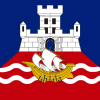
Flag |
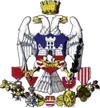
Coat of arms |
|
| Location of Belgrade within Serbia
|
| Coordinates: {{#invoke:Coordinates|coord}}{{#coordinates:44|49|14|N|20|27|44|E|type:city
|
|
|
name=
}}
|
| Country
|  Serbia Serbia
|
| District
| City of Belgrade
|
| Municipalities
| 17
|
| Establishment |
before 279 B.C.E. (Singidunum)[1] |
| Government |
| - Mayor
| Dragan Đilas (DS) |
| - Ruling parties
| DS/G17+/SPS-PUPS/LDP |
| Area [2] |
| - City
|
359.96 km² (139 sq mi) |
| - Urban |
869 km² (335.5 sq mi) |
| - Metro |
3,222.68 km² (1,244.3 sq mi) |
| Elevation [3] |
117 m (384 ft) |
| Population (2011)[4] |
| - City |
 1,154,589 1,154,589 |
| - Density |
3,207.5/km² (8,307.4/sq mi) |
| - Metro |
 1,639,121 1,639,121 |
| - Metro Density |
508.6/km² (1,317.3/sq mi) |
| Time zone |
CET (UTC+1)
|
| - Summer (DST) |
CEST (UTC+2) |
| Postal code |
11000
|
| Area code(s) |
(+381) 11 |
| Car plates |
BG |
| Website: www.beograd.rs
|
Belgrade is the capital and largest city of Serbia. The city lies at the confluence of the Sava and Danube Rivers in north central Serbia, where the Pannonian Plain meets the Balkan Peninsula. With a population of over 1.9 million (estimate 2008), Belgrade is the largest city in the territory of the former Yugoslavia and the fourth largest in Southeastern Europe, after Istanbul, Athens, and Bucharest.
One of Europe's oldest cities, with a history of 7000 years, Belgrade's wider city area was the birthplace of the largest prehistoric culture of Europe, the Vinča culture. The foundation of the city itself dates back to Celtic and later, Roman periods, followed by the settlement of Slavs around the seventh century. Since ancient times it has been an important focal point for commercial traffic, an intersection of the roads of Eastern and Western Europe. Today it is the central economic hub of Serbia, and the capital of culture, education and science.
The city suffered from corruption and abuse of power during the Miloševic-era, including mismanagement of the economy, as well as from years of economic sanctions, wars and damage to the infrastructure. A focus of the city's, and the nation's, leaders has been stabilization of the economic and social services systems. The government has committed itself to pursue socially accountable policy in an attempt to avoid social stratification of the population which has occurred in some former socialist countries during their periods of transition.
Geography
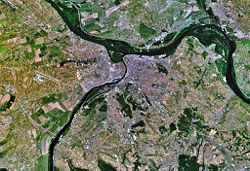
Satellite view of Belgrade.
Belgrade lies at the confluence of the Sava and Danube rivers in north central Serbia, where the Pannonian Plain meets the Balkan Peninsula. There, three trade routes exist - one from Vienna to the Black Sea along the Danube River valley, another along the Sava River valley toward Trieste, and a third along the Morava and Vardar rivers to the Aegean Sea.
On the right bank of the Sava, central Belgrade has hilly terrain, while the highest point of Belgrade proper is Torlak hill at 994 feet (303 meters). The mountains of Avala, at 1677 feet (511 meters), and Kosmaj, 2060 feet (628 meters) lie south of the city. Across the Sava and Danube, the land is mostly flat, consisting of alluvial plains and loessial plateaus.
The Danube flows through over 37 miles (60 km) of the area, while the Sava covers nearly 19 miles (30 km). The city's riverbanks cover 124 miles (200 km). There are 16 river islands in the area, the best known being Ada Ciganlija, Veliko ratno ostrvo and Gročanska ada. Belgrade also has many wooded areas, such as Kosmaj, Avala, Trešnja, Lipovica, Topčider, Obrenovački zabran and Bojčin.
Belgrade has a moderate continental climate. The hottest month is July, with an average temperature of 71.8°F (22.1°C), and the January temperature averages 34°F (1°C). Belgrade receives 27.56 inches (700mm) of precipitation a year.
The historical core of Belgrade (today's Kalemegdan) is on the right bank of the rivers. Since the nineteenth century, the city has expanded south and east, and after World War II, New Belgrade was built on the Sava's left bank, merging Belgrade with Zemun. Smaller residential communities across the Danube, such as Krnjača and Ovča, also merged with the city.
The city has an urban area of 139 square miles (360 square kilometers), while its metropolitan area covers 1244.4 square miles (3223 square kilometers).
History
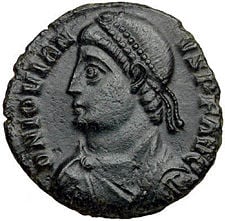
Flavius Iovanus, Roman Emperor from Singidunum
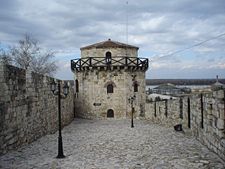
Belgrade Fortress - Jakšić's Tower.
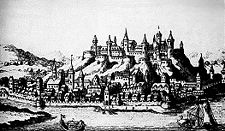
Belgrade in the sixteenth century
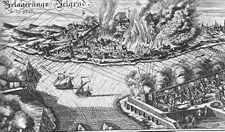
Austrian conquest of Belgrade: 1717 by Eugene of Savoy, during the Austro-Turkish War of 1716-1718

Knez Mihailova street at the beginning of the twentieth century
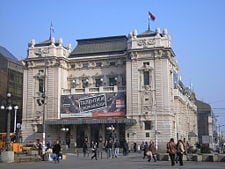
National Theatre in Belgrade
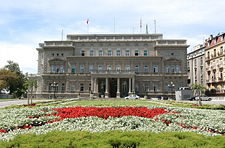
The Old Palace, seat of the Assembly of the City of Belgrade.
The Neolithic Starčevo and Vinča cultures existed in or near Belgrade about 7000 years ago. Settled in the fourth century B.C.E. by a Celtic tribe, the Scordisci, the city's first recorded name was Singidūn, before becoming the Roman settlement of Singidunum in the first century C.E. Roman Emperor Jovian (331-364), who re-established Christianity as the official religion of the Roman Empire, was born in Singidunum. In 395, the site passed to the Eastern Roman or Byzantine Empire. Across the Sava from Singidunum was the Celtic city of Taurunum (Zemun).
Slavs arrive
Singidunum was invaded by Huns, Sarmatians, Ostrogoths and Avars before the arrival of the Slavs around 630. The Frankish Kingdom destroyed the Avars in the ninth century. The Slavic name Beligrad appeared around 878, during the rule of the First Bulgarian Empire. The city remained a battleground between the Byzantine Empire, the Kingdom of Hungary, and the First Bulgarian Empire for about 400 years. The city hosted the armies of the First (launched 1096) and the Second Crusades (1147–1149). While passing through during the Third Crusade (1189–1192), Frederick Barbarossa saw Belgrade in ruins. Capital of the Kingdom of Syrmia since 1284, the first Serbian king to rule over Belgrade was Dragutin (died 1316), who received it as a gift from his father-in-law, the Hungarian king Stephen V.
Belgrade a haven
The Serbian Empire began to crumble after the Battle of Maritsa (1371), and the Battle of Kosovo (1389), as the Ottoman Empire conquered its southern territory. Belgrade flourished under despot Stefan Lazarević (1374-1427), who refortified the city's ancient walls, allowing the Despotate to resist the Ottomans for almost 70 years. The city became a haven for the many Balkan peoples fleeing from Ottoman rule, and is thought to have had a population of some 40,000–50,000.
In 1427, Stefan's successor Đurađ Branković had to return Belgrade to the Hungarians, and the Serbian capital was moved to Smederevo. During his reign, the Ottomans captured most of the Serbian Despotate, unsuccessfully besieging Belgrade first in 1440 and again in 1456. Over 100,000 Ottoman soldiers launched the famous Siege of Belgrade (July 4 to July 22, 1456), where the Christian army under John Hunyadi successfully defended the city, wounding the Sultan Mehmed II. This battle was regarded as "deciding the fate of Christendom."
Turkish conquest
Sultan Suleyman the Magnificent (1494-1566) and his 250,000 soldiers captured the fort on August 28, 1521, razed most of the city, and deported its Christian population to Istanbul. Belgrade was made an Ottoman Sanjak, attracting new inhabitants—Turks, Armenians, Greeks, Ragusan traders, and others – becoming the second largest Ottoman town in Europe with over 100,000 people. Turkish rule introduced Ottoman architecture and built many mosques.
In 1594, the Turks crushed a Serb rebellion. Albanian- born Grand vizier Sinan Pasha (1506-1596) is disdained by the Serbs for ordering, in 1595, that the relics of Saint Sava, the founder of the independent Serbian Orthodox Church in the twelfth century, be burned as a revenge for Serbs siding with the Habsburgs in the preceding border skirmishes. Further deportations to Istanbul followed.
Austrian occupation
Habsburg Austria occupied Belgrade three times (1688–1690, 1717–1739, 1789–1791), but the Ottomans recaptured and razed the city each time. This was the period of the two Great Serbian Migrations, in which hundreds of thousands of Serbs, led by their patriarchs, retreated together with the Austrians into the Habsburg Empire, settling in today's Vojvodina and Slavonia.
Serbian uprisings
During the First Serbian Uprising, the Serbian revolutionaries held the city from January 8, 1806, until 1813, when the Ottomans retook the city. After the Second Serbian Uprising in 1817, Serbia reached semi-independence, which the Ottoman Porte recognized in 1830. When Serbia reached full independence in 1878, and became the Kingdom of Serbia in 1882, Belgrade became a key city, but Serbia remained overwhelmingly agrarian and poor. In 1900, the capital had only 69,100 inhabitants, by 1905 the population had grown to more than 80,000, and by the outbreak of World War I in 1914, it had surpassed the 100,000 citizens.
World War I
Gavrilo Princip's assassination of Archduke Franz Ferdinand of Austria and his wife Sophie, Duchess of Hohenberg, in Sarajevo on June 28, 1914, triggered World War I. The Austro-Hungarian Army took Belgrade on November 30, 1914, but Serbian troops took the city on December 15. Belgrade fell to German and Austro-Hungarian troops on October 9, 1915. The city was liberated by Serbian and French troops on November 5, 1918.
After the war, Belgrade became the capital of the new Kingdom of Serbs, Croats and Slovenes, renamed the Kingdom of Yugoslavia in 1929. The kingdom was split into banovinas, and Belgrade, together with Zemun and Pančevo, formed a separate administrative unit. Belgrade's population grew to 239,000 by 1931 (incorporating the town of Zemun, formerly in Austria-Hungary), and 320,000 by 1940. In 1927, Belgrade's first airport opened, and in 1929, its first radio station began broadcasting. The Pančevo Bridge across the Danube was opened in 1935.
World War II
On March 25, 1941, the government of regent Crown Prince Paul signed the Tripartite Pact with the Axis powers to avoid war. This sparked mass protests in Belgrade and a military coup d'état led by Air Force commander General Dušan Simović, who proclaimed King Peter II to be of age to rule the realm. The German Luftwaffe bombed the city on April 6, 1941, and up to 17,000 citizens were killed. German, Italian, Hungarian, and Bulgarian forces invaded Yugoslavia. Belgrade's eastern suburbs were incorporated into a Nazi puppet state, the Independent State of Croatia, while Belgrade became the seat of another puppet government, headed by General Milan Nedić.
During the summer and fall of 1941, in reprisal for guerrilla attacks, Germans carried out several massacres of Belgrade citizens; in particular, members of the Jewish community were subject to mass shootings. General Franz Böhme, the German Military Governor of Serbia, rigorously enforced the rule that for every German killed, 100 Serbs or Jews would be shot.
The Allies bombed Belgrade on April 16, 1944, killing 1600 people. Communist Yugoslav Partisans and the Red Army liberated the city on October 20, 1944. On November 29, 1945, Marshal Josip Broz Tito proclaimed the Federal People's Republic of Yugoslavia in Belgrade (later to be renamed to Socialist Federal Republic of Yugoslavia on April 7, 1963).
Belgrade grows
During the post-war period, Belgrade developed as an industrial center. The city's first television station began broadcasting in 1958. In 1961, the conference of Non-Aligned Countries was held in Belgrade under Tito's chairmanship. In 1968, student protests against Tito led to street clashes between students and the police. In March 1972, Belgrade was at the center of the last outbreak of smallpox in Europe.
After communism
On March 9, 1991, Vuk Drašković led 150,000 people in protest against Serbian president Slobodan Milošević (1941-2006). Two people were killed, 203 injured and 108 arrested. Tanks were deployed to restore order. Further protests were held from November 1996 to February 1997 after alleged electoral fraud at local elections, bringing Zoran Đinđić to power, the first non-communist mayor of Belgrade since World War II. NATO bombing during the Kosovo War in 1999 caused substantial damage to Belgrade. After the elections in 2000, street protests by over 800,000 people resulted in the ousting of Milošević, on October 5, 2000.
Government
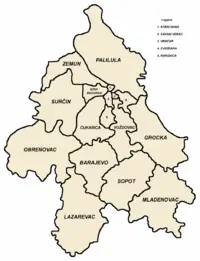
Map of the municipalities of Belgrade.
Serbia is a parliamentary representative democratic republic. The chief of state is the president, elected for a five-year term, and the prime minister is the head of government, and of a multi-party system. The unicameral Serbian national assembly, which has 250 members, elects the prime minister. The part of Serbia that is neither in Kosovo nor in Vojvodina, often called "Serbia proper," is divided into 29 districts plus the City of Belgrade.
As a separate territorial unit, Belgrade has an autonomous city government. The Civic Assembly of Belgrade has 110 councilors who are elected for four-year terms. The 2008 majority parties are the same as in the Parliament of Serbia. The city is divided into 17 municipalities, 10 with "urban" status, and seven with "suburban" status. While each has its own local council, the suburban municipalities have slightly expanded powers, regarding construction, town planning and public utilities.
Most municipalities are on the southern side of the Danube and Sava rivers, in the Šumadija region. Zemun, Novi Beograd, and Surčin are on the northern bank of the Sava, and Palilula, spanning the Danube, is in both the Šumadija and Banat regions.
Economy
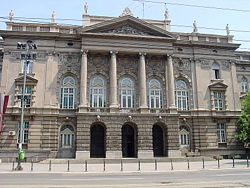
Faculty of Electrical Engineering, Architecture and Civil Engineering, University of Belgrade.
Belgrade is the most economically developed part of Serbia. The rocky transition from the former Yugoslavia to the Federal Republic during the early 1990s left Belgrade, like the rest of the country, harmed by an international trade embargo and hyperinflation. Yugoslavia overcame the problems of inflation in the mid-1990s. By 2008, over 30 percent of Serbia's GDP was generated by the city, which also has over 30 percent of Serbia's employed population. In terms of GDP per capita, Belgrade holds the region's top position, with a figure of $US18,204 in terms of purchasing power parity.
Many notable companies are based in Belgrade, including Jat Airways, Telekom Srbija, Telenor Serbia, Delta Holding, regional centers for Société Générale, Intel,Motorola, Kraft Foods, Carlsberg, Microsoft, Zepter, Japan Tobacco and many others.
Belgrade is a media hub. The city hosts the headquarters of the national broadcaster Radio Television Serbia - RTS, the RTS record label is based there, as is commercial broadcaster RTV Pink. High-circulation daily newspapers published in Belgrade include Politika, Blic, Večernje novosti, Glas javnosti, Press and Sportski žurnal.
Belgrade has an extensive public transport system based on buses (118 urban lines and more than 300 suburban lines), trams (12 lines), and trolleybuses (eight lines). Belgrade has a commuter rail network, Beovoz. Travel by coach is popular. The motorway system provides for easy access to Novi Sad and Budapest in the north; Niš to the south; and Zagreb, to the west.
Belgrade has numerous bridges—the two main ones being Branko's bridge and Gazela, both of which connect the core of the city to Novi Beograd (New Belgrade).
The Port of Belgrade is on the Danube. The city is also served by Belgrade Nikola Tesla Airport, 12km west of the city center. At its peak in 1986, nearly three million passengers traveled through the airport, though that number dwindled to a trickle in the 1990s. In 2007, 2.5 million passengers passed through.
Traffic congestion has become a problem. This was expected to be alleviated by the construction of a bypass, an "inner magistral semi-ring," and new bridges across the Sava and Danube rivers.
Demographics
Belgrade had 1,531,741 eligible voters in December 2007, according to the city's Institute for Informatics and Statistics. The number of registered voters nearly exceeded the entire population of the city six years earlier.
Belgrade has attracted people of varied ethnicity, who went there seeking a better life, or who fled as refugees from war and ethnic cleansing. The main ethnic groups are Serbs (1,203,045), Montenegrins (25,000), Roma (19,000), Croats (7000), Macedonians (8372), and Muslims by nationality (4617). Belgrade is home to up to 20,000 Chinese, who began moving there in the mid-1990s. Blok 70 in New Belgrade is known locally as the Chinese quarter.
Many Middle Easterners, mainly from Syria, Iran, Jordan and Iraq, arrived to study during the 1970s and 1980s, and have remained. Afghani and Iraqi Kurdish refugees are among some of the recent arrivals from the Middle East.
The Serbian language is the official language. Other languages include Romanian, Hungarian, Slovak, Ukrainian, and Croatian. Many are able to communicate in English as well, though somewhat limitedly.
The Serbian Orthodox community is by far the largest, with 1,429,170 adherents. There are 20,366 Muslims, 16,305 Roman Catholics, and 3796 Protestants. There was once a significant Jewish community, but following the Nazi occupation, and many Jews' subsequent emigration to Israel, their numbers have fallen to a mere 515 (2008).
Belgrade has two state universities and several private institutions for higher education. The "Great School," founded in Belgrade in 1808, was the earliest location of higher education in Serbia. The Lyceum followed in 1841, when it was moved from Kragujevac. By 1905, it had evolved into the University of Belgrade, which has more than 70,000 students.
Places of Interest
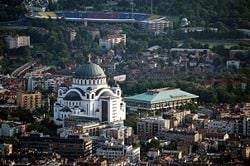
Temple of Saint Sava and the National Library of Serbia.
The historic areas and buildings of Belgrade are among the city's premier attractions. Belgrade has wildly varying architecture, from the center of Zemun, typical of a Central European town, to the more modern architecture and spacious layout of New Belgrade. The oldest buildings date only from nineteenth century, due to frequent wars and destruction. The oldest public structure in Belgrade is a nondescript Turkish turbe, while the oldest house is a modest clay house on Dorćol, from late eighteenth century. Of interest are:
- Skadarlija, located in the municipality of Stari Grad (Old town), and considered the main bohemian quarter of Belgrade. More traditional Serbian nightlife may be experienced there, accompanied by traditional music known as Starogradska. Skadar Street (the center of Skadarlija) and the surrounding neighborhood are lined with some of Belgrade's best and oldest traditional restaurants (called kafanas in Serbian). The neighborhood has Belgrade's oldest brewery, founded in the first half of the nineteenth century.
- The National Museum, founded in 1844, houses a collection of more than 400,000 exhibits,(over 5600 paintings and 8400 drawings and prints) including many foreign masterpieces and the famous Miroslavljevo Jevanđelje (Miroslav's Gospel).
- The Military Museum, which houses a wide range of more than 25,000 military exhibits dating as far back as to the Roman period, as well as parts of a F-117 stealth aircraft shot down by Yugoslav forces.
- Zemun, which is considered by the local population as a separate, and more cultural city than Belgrade. Belgraders consider Zemun an outer, Austro-Hungarian suburb of Belgrade.
- Nikola Pašić Square, is one of the central town squares, is named after Nikola Pašić who served as mayor of Belgrade, prime minister of Serbia and prime minister of Yugoslavia.
- The Kalemegdan Fortress, is the core and the oldest section of the urban area of Belgrade and for centuries the city population was concentrated only within the walls of the fortress.
- Knez Mihailova St, the favorite strolling avenue of the city.
- The Temple of Saint Sava is the largest Orthodox church in use in Belgrade.
- The Yugoslav Film Archive, with around 95,000 copies of films, is among the 10 largest archives in the world.
The city was one of the main centers of the Yugoslav New Wave music in the 1980s. There are numerous theaters, the most prominent of which are National Theatre, Theatre on Terazije, Yugoslav Drama Theatre, Zvezdara Theatre, and Atelier 212. Belgrade's two opera houses are: National Theatre and Madlenijanum Opera House. After Serbia's Marija Šerifović won the Eurovision Song Contest in 2007, Belgrade hosted the Eurovision Song Contest 2008.
There are numerous parks, monuments, cafés, restaurants and shops. Belgrade hosts the Belgrade Film Festival, Theatre Festival, Summer Festival, Music Festival, Book Fair, and the Belgrade Beer Festival. There are approximately a thousand sports facilities in the city.
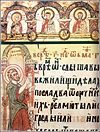 Miroslav's Gospel, twelfth century manuscript entered the UNESCO's Memory of the World Programme in 2005 |
|
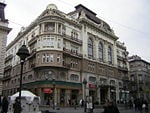 The Serbian Academy of Sciences and Arts, erected in 1922 |
|
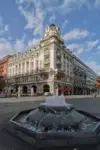 Knez Mihailova (Prince Mihailo) Street, Belgrade's favorite pedestrian avenue |
Looking to the Future
Since its original settlement as the Roman city known as Singidunum, Belgrade has arisen (according to legend and verified history) from its ashes 38 times. Located at the convergence of three historically important routes between Europe and the Balkans—east-west along the Danube River valley from Vienna to the Black Sea; westward along the valley of the Sava River toward Trieste and northern Italy; and southeast along the valleys of the Morava and Vardar rivers to the Aegean Sea—has given it a history of possession by various foreign powers. Its location has enabled it to play an important role in several junctures in history.
The Balkan Peninsula, on which Belgrade lies, is a mélange of cultures and ethnicities. The virulent animosity among different groups has led to civil war, and to the area's nickname as the "Balkan tinderbox." Belgrade, emerging from an era of war and repression is, in the early twenty-first century, a work in progress. Its history has shaped it, yet it is up to its leaders and contributing citizens to determine its future.
While the city, along with the entire nation, suffered from corruption and abuse of power during the Miloševic-era, since that time its leaders have focused their efforts on the stabilization of the economic and social services systems. The government has committed itself to pursue socially accountable policy in an attempt to avoid social stratification of the population which has occurred in some former socialist countries during their periods of transition.
The City of Belgrade has received various domestic and international honors, including the French Légion d'honneur in 1920, the Czechoslovak War Cross, the Serbian Karađorđe's Star with Swords and the former Yugoslavian Order of the National Hero (proclaimed on October 20 1974, the anniversary of the overthrow of Nazi German occupation during World War II).[5]
In the competition for European cities and regions of the future in 2006 and 2007, organized by the Financial Times magazine, Belgrade was proclaimed “City of the Future in Southern Europe” in March 2006 in Cannes. Apart from Belgrade, awards also went to Paris as the “City of the Future in Western Europe,” Brno as the “City of the Future in Central Europe,” Baku as the “City of the Future in Eastern Europe” and London as the “City of the future in Northern Europe,” which was also named “European City of the Future 2006/07.” [6]
The country is in the process of negotiating the Stabilization and Association Agreement with the European Union, and is the world’s leading reformer as stated by the World Bank. In addition, the pace of structural reforms is ahead of that in other transition countries according to the European Bank for Reconstruction and Development.
As a leading educational center comprising 62 university-level institutions, Belgrade boasts a well-educated, fast learning, multilingual and IT literate labor force. Over 8,000 students graduate from Belgrade University every year, with one-third of them adding to the traditionally strong engineer base. According to Gallup International, the city's percentage of English speakers is the highest in Central and Eastern Europe, and an increasing number of western business schools open their affiliates in Belgrade.
These statistics show Belgrade's determination to join the ranks of progressive European cities. A critical issue will be its capacity to reconcile the major ethnic factions that define its current identity.
Notes
- ↑ Ancient Period. City of Belgrade. Retrieved March 16, 2012.
- ↑ Territory. City of Belgrade. Retrieved March 16, 2012.
- ↑ Geographical position. City of Belgrade. Retrieved March 16, 2012.
- ↑ 2011-11-15, PRVI REZULTATI, Konferencija za novinare, Statistical Office of the Republic of Serbia Retrieved March 16, 2012.
- ↑ City of Belgrade. Received Decorations Retrieved August 12, 2008.
- ↑ The Financial Times Limited. February 06, 2006. European Cities of the Future 2006/07 Retrieved August 12, 2008.
References
ISBN links support NWE through referral fees
- City of Belgrade. Belgrade Retrieved August 26, 2019.
- Lebl, Ženi. Until "the final solution": the Jews in Belgrade 1521-1942. Bergenfield, NJ: Avotaynu, 2007. ISBN 978-1886223332
- Levinsohn, Florence Hamlish. Belgrade: among the Serbs. Chicago: I.R. Dee, 1994. ISBN 978-1566630610
- Norris, David A. Belgrade: a cultural history. Oxford: Oxford University Press, 2008. ISBN 0195376099
- Pavić, Milorad. A short history of Belgrade. Belgrade: Prosveta, 1990. ISBN 978-8607005390
- Tešanović, Jasmina. The diary of a political idiot: normal life in Belgrade. San Francisco: Midnight Editions, 2000. ISBN 978-1573441148
Credits
New World Encyclopedia writers and editors rewrote and completed the Wikipedia article
in accordance with New World Encyclopedia standards. This article abides by terms of the Creative Commons CC-by-sa 3.0 License (CC-by-sa), which may be used and disseminated with proper attribution. Credit is due under the terms of this license that can reference both the New World Encyclopedia contributors and the selfless volunteer contributors of the Wikimedia Foundation. To cite this article click here for a list of acceptable citing formats.The history of earlier contributions by wikipedians is accessible to researchers here:
The history of this article since it was imported to New World Encyclopedia:
Note: Some restrictions may apply to use of individual images which are separately licensed.
